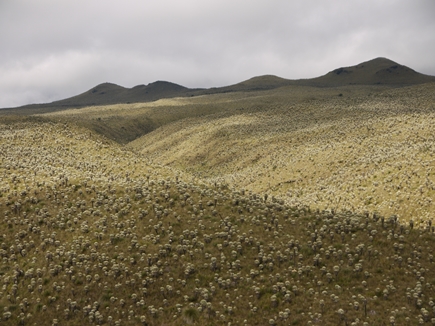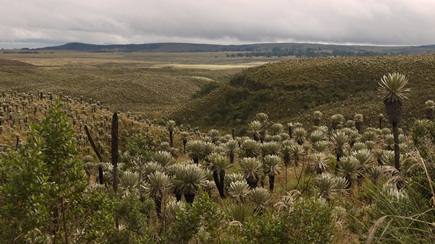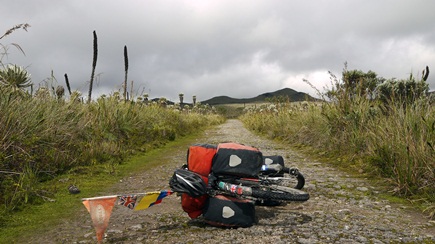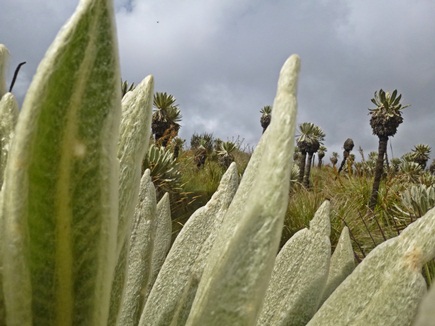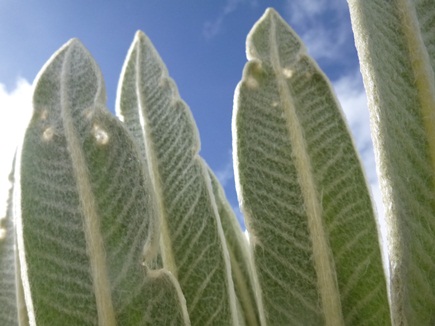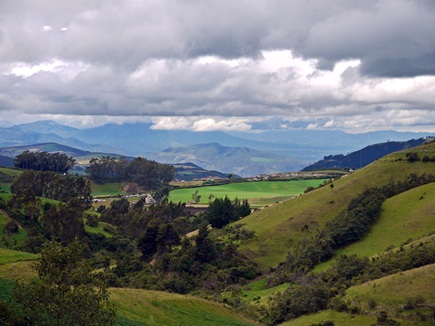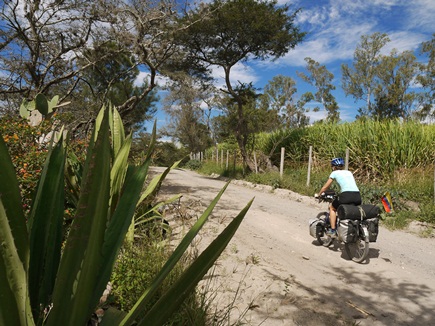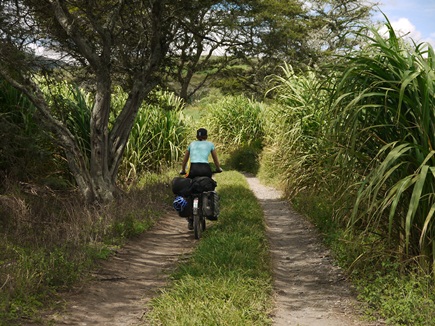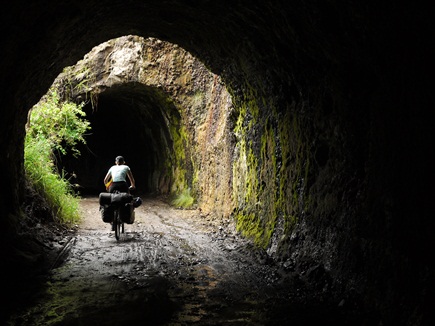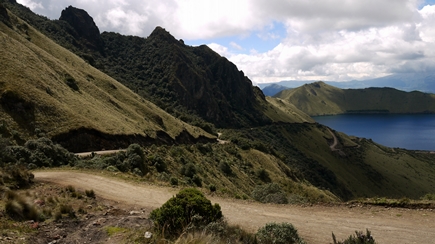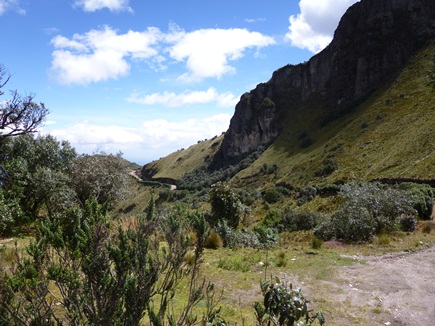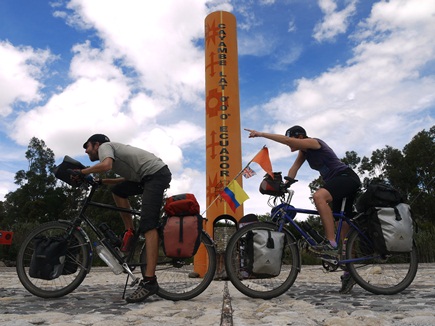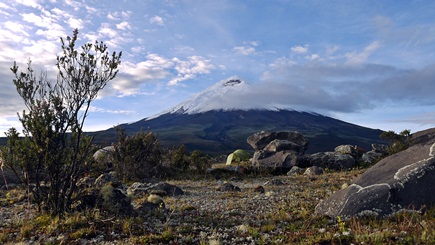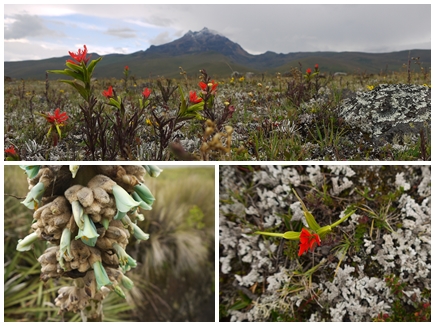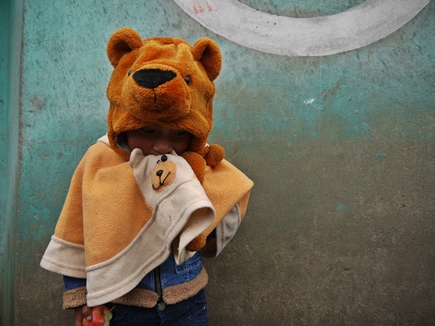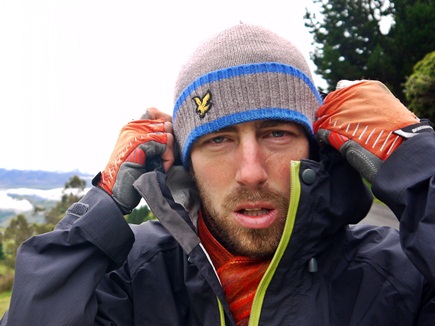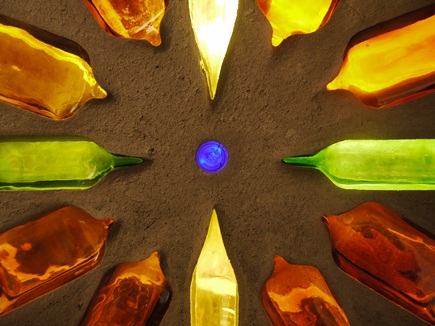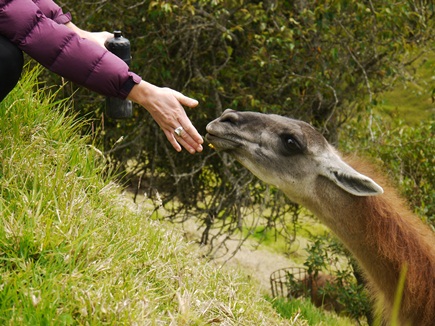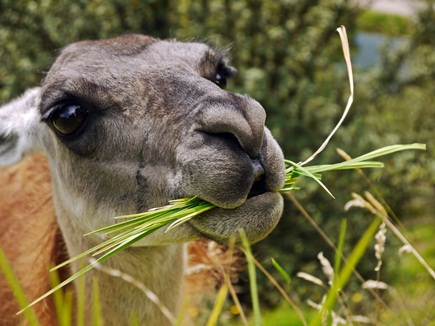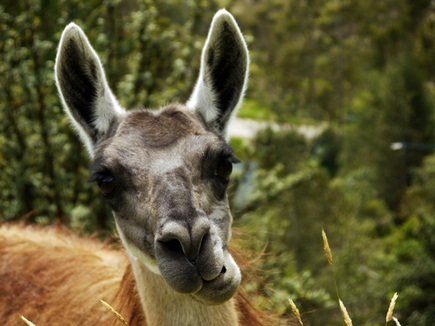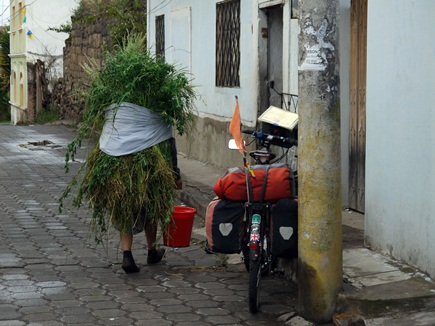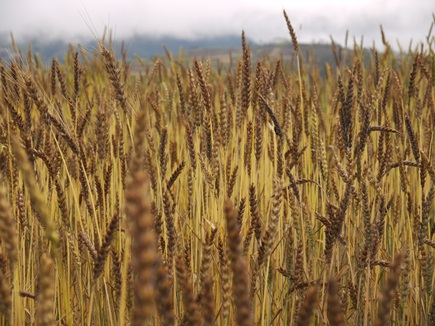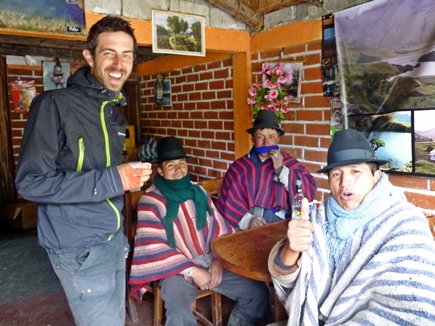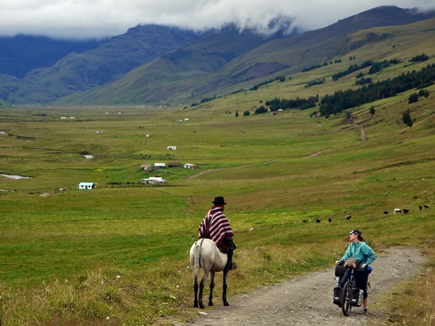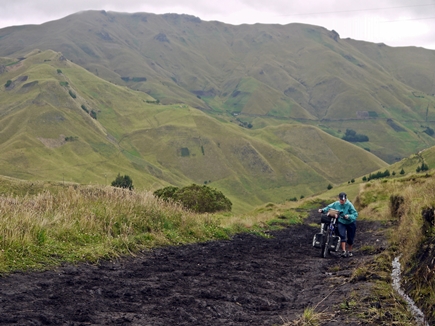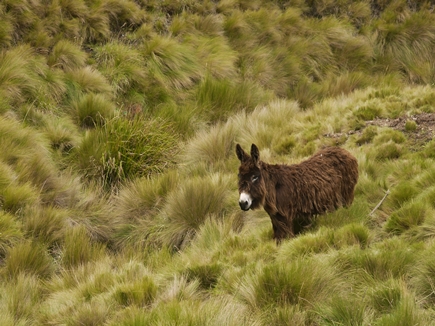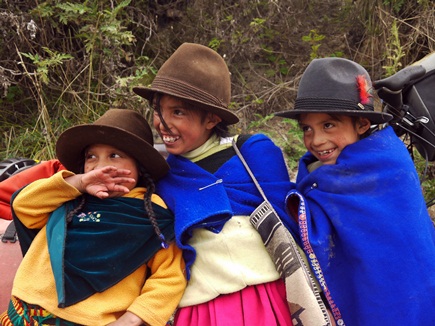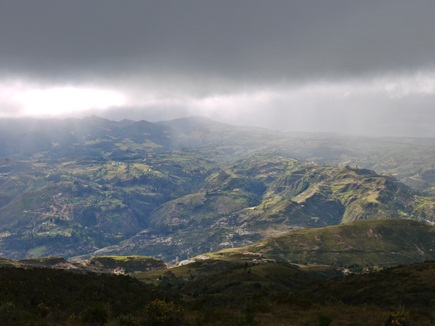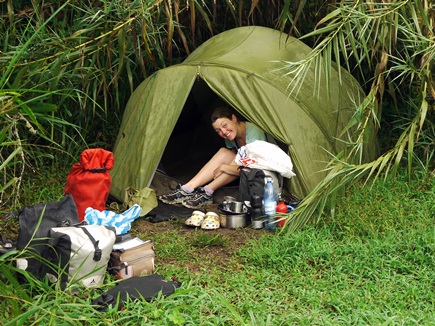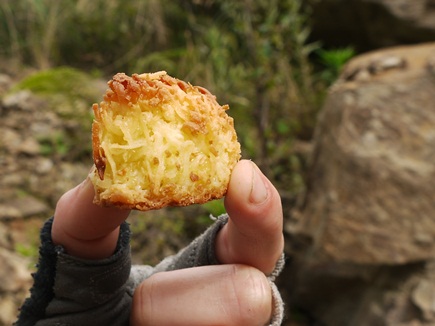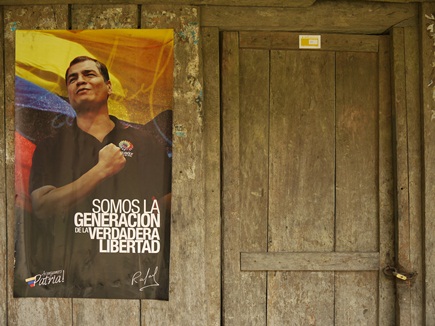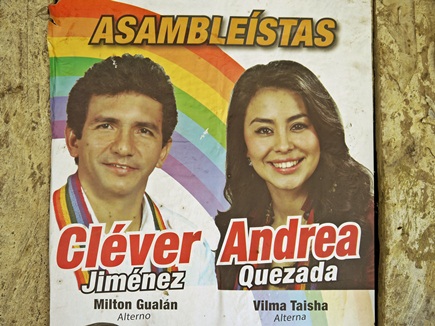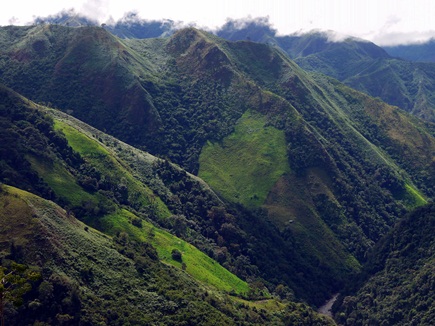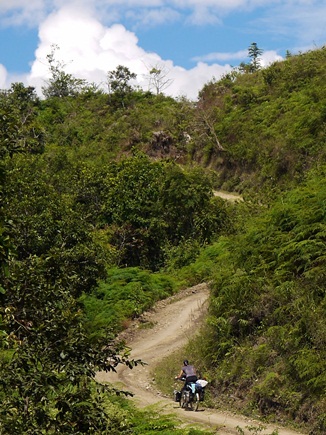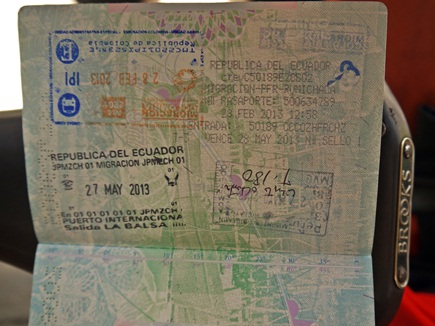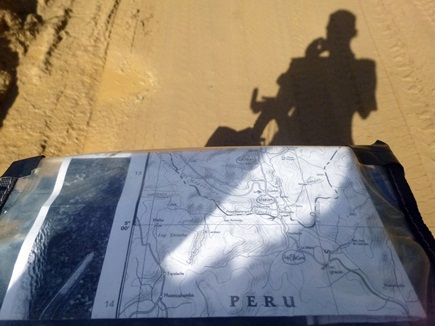Mitad del mundo
March 12th, 2013
My head full of Colombia as we crossed the border at Tulcán, it was difficult to concentrate on Ecuador and what it might be like. Fit to burst at saying goodbye to a country I had fallen in love with and knowing that it would be a long time before I saw the friends I made there again, it was with some reluctance that I handed my passport over to gain entry into Ecuador.
Thankfully Ecuador had ample distractions waiting for me. We were instantly wooed by three successive days of beautiful dirt riding, and began to discover a wider range of tastier food with more flavour than we had recently enjoyed. The thrill of entering a new country came flooding back. After six months in Colombia, I had felt at home where things had become comfortable, easy. Now in Ecuador with a new currency, a new cuisine, a new backdrop, it was time to start discovering again.
As we got our bearings and adjusted to bigger landscapes with jaw dropping views, another moment grabbed my attention. There was a marker in our journey that I hadn’t really acknowledged, until we arrived right there, on the line…we had reached la mitad del mundo – the Equator. As we slowed to cross the line hand in hand – on bikes we had pedalled all the way from Alaska – I felt quite proud.
I realised that we can say that we have pretty much cycled halfway down the world, clocking up 18,200km in the process. Feeling impressed with that, and happy to be in Ecuador, I took a moment to mark the occasion with a big hug for my ever- patient riding partner, a celebratory munch on a banana (of course) and the obligatory poses for a series of silly photos on top of the line itself at the monument just outside Quito.
Sarah

The border town of Tulcán isn't Ecuador's most picturesque place but its newly renovated market with delicious fruit juice stalls, free wi-fi and cheap set lunches were enough to give us pleasant welcome into the country.
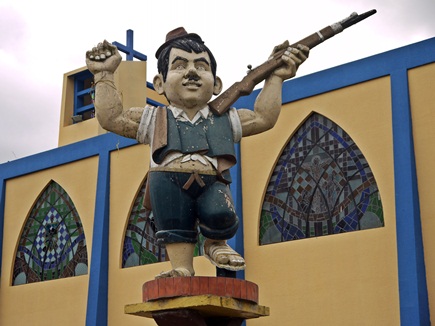
We'd heard from other cyclists of a road leaving Tulcán leading up into the páramo highlands that was found by looking for the statue of a dwarf resembling Hitler, brandishing a rifle outside a modernist church….with such weird and specific instructions we couldn't really go wrong and sure enough, we found the statue and followed our road…

…to a remote camp spot at around 2800m where we dropped the bikes, put on all of our clothes and fired up the stove to make a hot chocolate in an attempt to warm up in Ecuador's cooler climes.
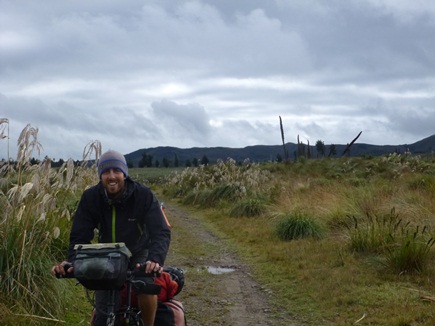
After a night of pure silence, camped under a blanket of crisp, crystal stars we were up early and raring to go across the páramo…

Around every corner these plants, which are only found above 3000m in Venezuela, Colombia and Ecuador, were waiting to welcome us….

There are other species of plant that thrive here too…delicate colours and textures we were surprised to find in such harsh conditions.
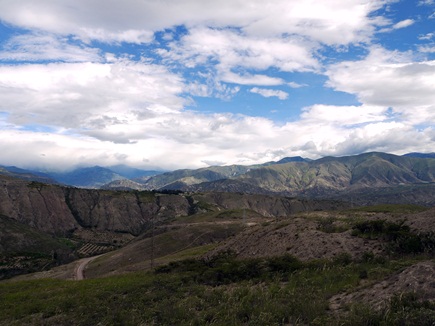
…down and down and into more rugged terrain that reminds us we have truly reached the Andes. Those mountains looming ahead of us today, will be the climbs we have to undertake tomorrow, and the next day, and the next day.

Reaching Salinas, just off the Pan American which we have (smugly) successfully avoided so far, we encounter a sleepy forgotten town on the edge of the mountains…
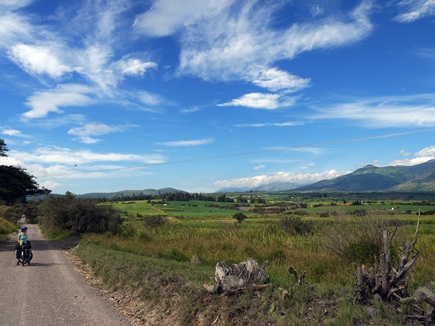
…and on leaving, in another attempt to avoid the main road, we kind of make up a route as we go along. Using Volcano Cotacachi as a landmark, we stumble upon the old route to Ibarra…
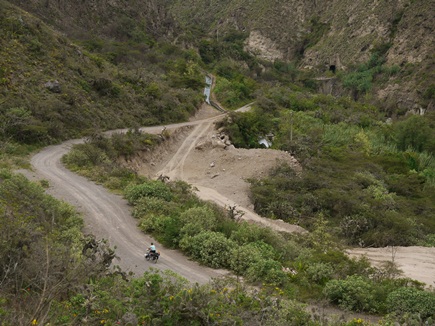
…which at first glance makes us think we've been a bit ambitious with our wanderings and we've hit a dead end. Beady eyed Jams spots an exit however and…
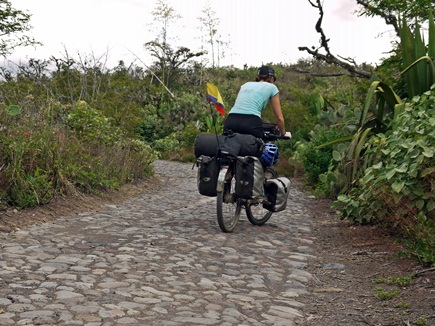
Throughout Central America, I wailed with discomfort whenever we reached a colonial town because it inevitably meant saddle-sore inducing cobbled streets. Imagine my dismay then at arriving in Ecuador to find that cobbled roads are not something reserved only for pretty towns here, but are seen as a legitimate road building technique. So it seems James will have to suffer much more of my complaining if all of the ascents ahead of us are to be cobbled.
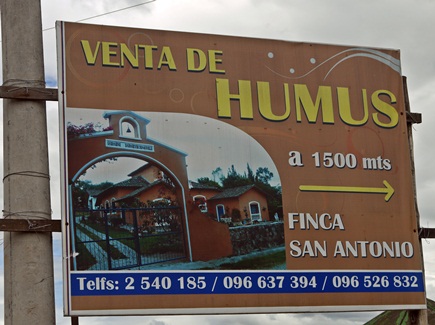
Excitement levels went up considerably when I saw this sign, thinking my favourite chickpea snack was for sale nearby…whilst I was salivating with anticipation, Jams helpfully pointed out that “humus” in this case is the Spanish word for soil…I know, I know, it's not even spelt the same way but after nearly two years of craving, you can't blame a girl for getting excited.
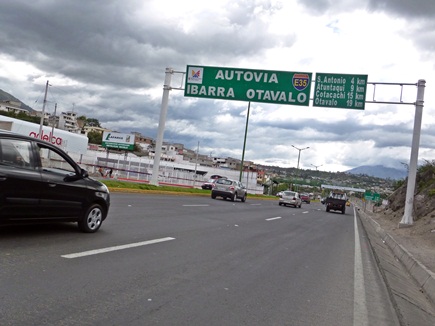
It couldn't have felt more different to our morning's ride when we hit the Pan American at Ibarra. From field tracks to four lane highway in just a few hours. Thankfully we only had to do 4km on this monstrosity before exiting again for a more peaceful route to Otavalo.

Along the way, we learned, from a helpful poster in a fruit and veg shop, that the current president of Ecuador, Rafael Correa, shares our passion for two wheels.

Ahead of us lie more mountains, greater altitude, more snow and colder weather than we will have experienced on this trip so far. We take the chance to stock up on woolly winter warmers in Otavalo, a town famous for a market selling deliciously snuggly clothing made from llama and alpaca wool.
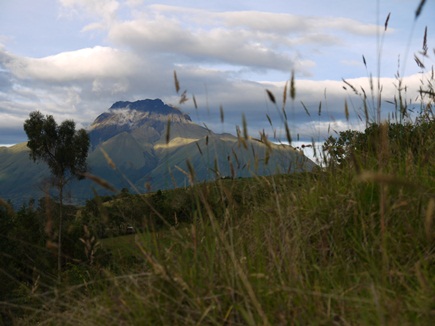
Another cobbled climb led us to a wonderful camping spot between two volcanoes. Looking right we had Imbabura standing majestically in the last of the evening light and…
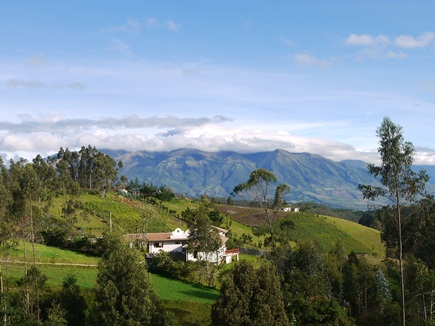
…looking left the summit of Cotacachi was shrouded in clouds but still there…looming from the other side. Ecuador, land of volcanoes.
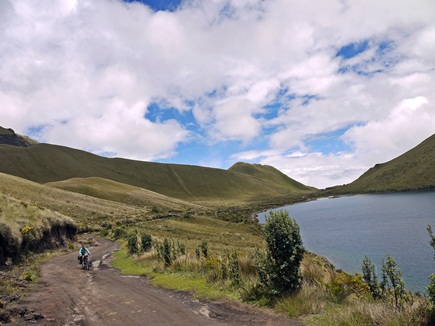
There are no pictures of our 14km cobbled climb up to the Lagunas de Mojanda, a series of lakes at 3700m, partly because it was extremely misty but also because it took every breath, every cell of the body to turn the pedals to get up there. We are definitely still adjusting to the altitude here, but it's all good training for when we expect to reach dizzy heights of 5000m in Bolivia. This was the first we saw of the lakes as we rounded the corner at the top of (what I thought was) the end of the climb.
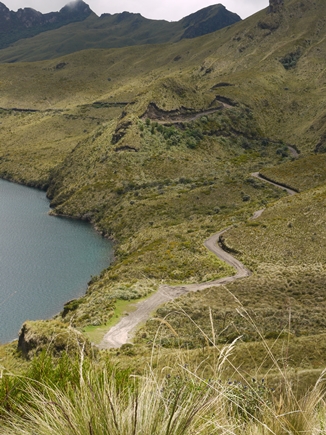
We had the place to ourselves and as the mist cleared and a deliciously warm sun showed itself, we followed the twisting path alongside these beautiful lakes.
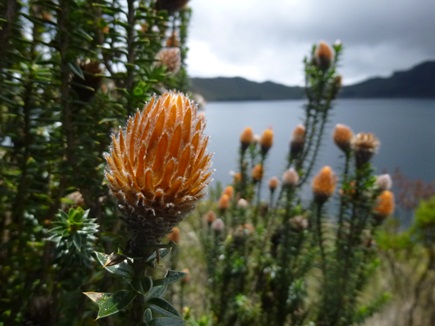
As with the páramo between Tulcán and El Angel, we were discovering stunning nature we'd never seen before. South America's version of thistles perhaps?
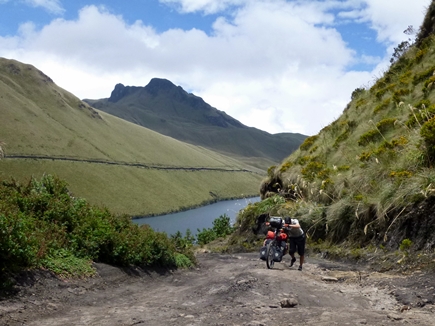
Rounding the lake, we were foolish to think the hard work was over and this steep section had us both off and pushing – we are thankful that we've got the weight of the bikes down as low as possible to be able to – just about – tackle tracks like this.

After lunch, sheltering out of the wind at an deserted tourist complex, the realisation slowly dawned on me that there was more climbing to come. If the lakes were in a basin, it was inevitable that we had to climb back out of it…steep grade on loose dirt after lunch…there was a lot of swearing. But at least the view was nice.
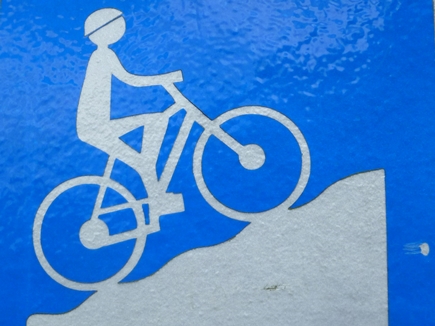
As I was choking to take in air when we got to the top, this sign managed to bring a grin to my face…a reminder, in case we needed it, that cyclists can expect steep climbs on uneven surfaces around here.
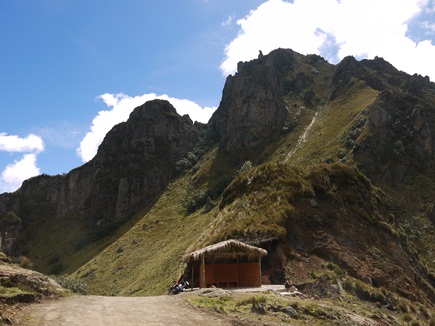
Finally we reach the top and at 4000m it's the highest climb of our trip so far. The rugged backdrop, fluffy white clouds and bright sunshine make it all seem worth it…

Setting out on the descent to Tabacundo, James looks as thought he's about to ride right off the edge and into the clouds.
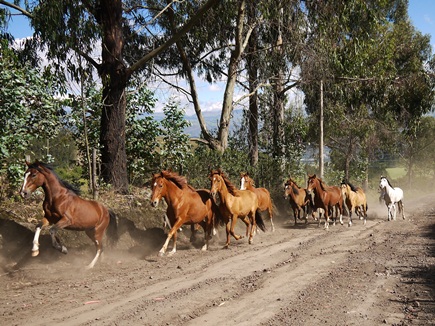
Halfway down the descent we are stopped in our tracks by a team of horses who demand all the space on the road as they gallop on by.

Arriving in Tabacundo, we decide it's time to try out some Ecuadorian snacks and we waste no time in ordering one of everything…so we can make some discerning choices of course. Clockwise from top left: potatoes with greens and toasted maize, wrapped humitas (maize dumplings with cheese and sugar), an unwrapped humita ready for eating and cheese empanadas…thankfully, everything was yummy and passed the test.
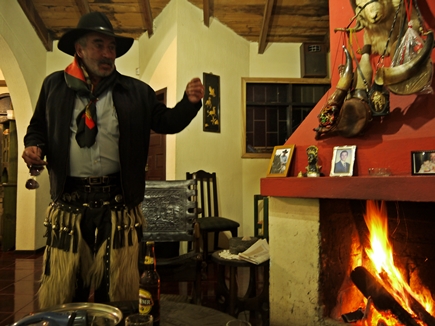
While I was stocking up with veg at the market, James was approached by Germán who runs a paintballing ranch just outside Tabacundo. He generously invited us to camp at his house where he and his wife Fabiola made us incredibly welcome. We were treated to an open fire, beer and delicious food, and even an exclusive performance of traditional costume and local dancing – usually only seen at the month long festival for St Peter and Paul held in June.
Snuggle up
March 31st, 2013
It’s been a chilly couple of weeks, mostly because we’ve been cycling around some of Ecuador’s highest points. Leaving the comfortable casa de ciclistas (and the perpetually generous Santiago and family) in Tumbaco near Quito felt like leaving a micro climate. Warm days – with sunshine and birdsong – and cool nights – perfect for sleeping in our tent in Santiago’s garage – gave way to snow-capped volcanoes and icy winds.
Climbing up to Volcán Cotopaxi and then up again to Lago Quilotoa had us digging out every scrap of warm clothing we’ve been carrying, and developing a new found respect for those who live their lives at high altitudes.
Sarah
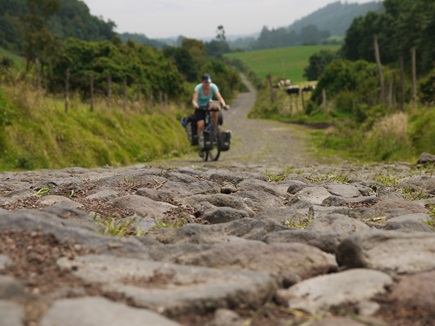
Cobbles keep you warm. A massive cobble sceptic, I found that they do have a benefit after all…tackling a 15km climb on cobbles definitely maintains a cosy body temperature.
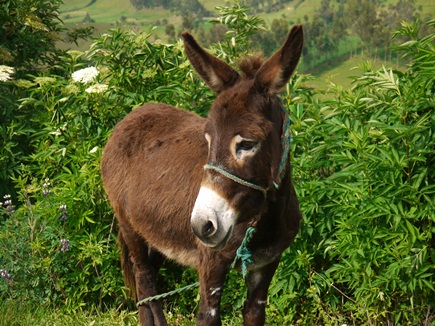
This donkey, just near volcano Cotopaxi, has just the right amount of snuggly fur to keep a smile on his face…ascending higher, the donkeys put on more fur, getting shaggier and hardier.

On the approach to Volcán Cotopaxi = layer up with all the clothes you've got and then sit back, pedal and enjoy the view. Riding your bike doesn't get much more spectacular than this.
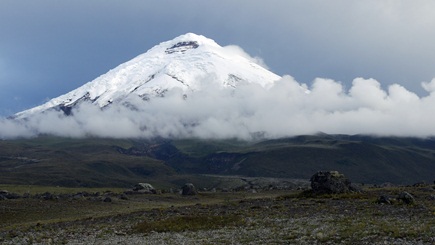
Determined to soak up this incredible view, we search around a boulder field for a good sized rock to shelter behind…

Not all of our campsites are as idyllic as this and we were so lucky that the volcano came out to play having been shrouded in cloud for most of the day.
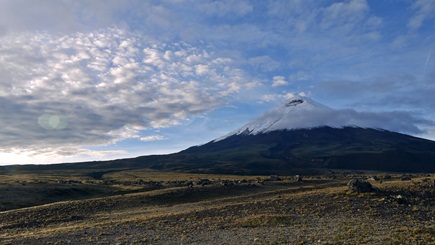
With just a few clouds and soft morning sunshine, Cotopaxi knows very well how to show off all of its 5897 metres.
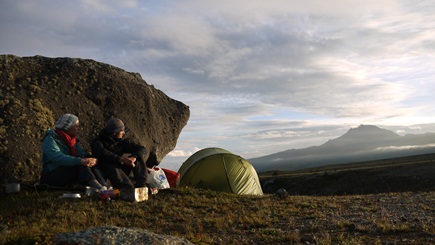
Never more grateful for our trusty little stove, we are making hot drinks throughout the day to keep warm. A shame then, that on this particularly crisp morning, we run out of fuel for our stove and have to abandon plans for coffee and porridge.
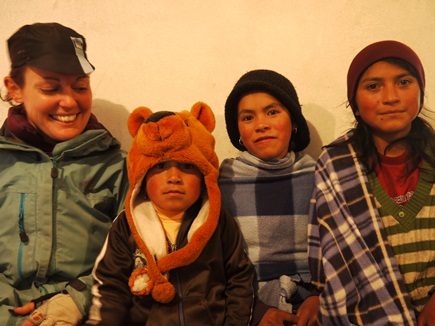
Arriving in the bleak little village of Yanaurcu Grande, we find Patricio pushing his five year old daughter home in a wheelbarrow. Everyone shelters together in his little shop from the miserable weather and then he kindly invites us to camp at his place across the square.
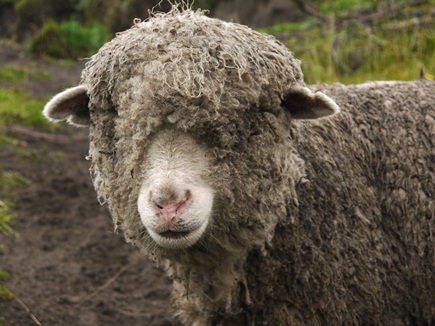
Not only bears trying to stay snuggly around here. The sheep in this neck of the woods have developed a dashing furry coat to keep the warm in and the chills out…quite how they manage to see anything is another story.
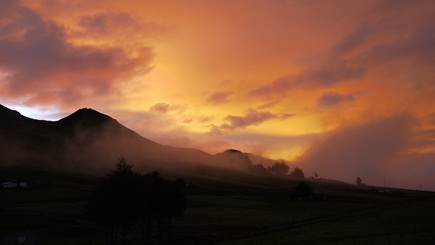
Camping in Patricio's sheltered yard is a blessing as the mist rolls in and the rain comes down; not before the day goes out with a spectacular sunset…

…and then an early morning farewell. Standing in the rain, with La Osita perched on my bike, we have a last minute giggle and wave goodbye before disappearing into the mist. The little bear is off to school and we are headed for the Quilotoa Loop, a series of roads taking us past Lago Quilotoa, a crater lake at 3800m.

Climbing out of Yanaurcu Grande, another volcano comes into view. The snow covered twin peaks of Illiniza.

On a bitterly cold descent to the village of Isinliví, we meet Patricio's father coming towards us on his donkey. With only the traditional felt hat common in these parts and a fleece jacket to keep him warm, I am surprised he's not shivering away like us.
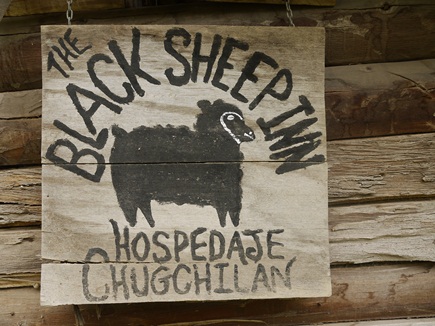
After a couple of nights camping in the cold, we're grateful to come indoors at Chugchilán. Thanks to a very generous gift from Raul & Lina in Medellín, we can splash out and spend a night at the lovely Black Sheep Inn…

…where the eco-tourism credentials are impressive. Recycled rainwater feeds a living flower bed in the toilet…
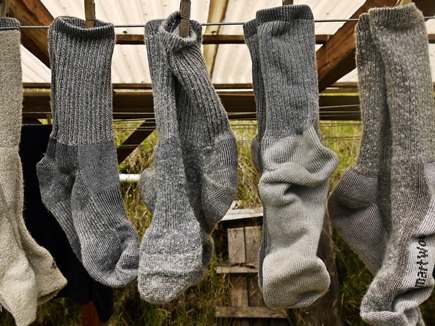
I am half tempted to pinch a pair of these snugglies while we are at the Black Sheep. My thick smart wool socks are currently my most prized possessions and seeing these beauties all lined up makes me crave a second pair.
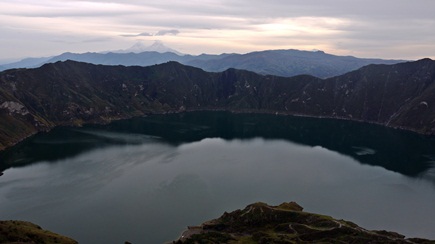
Half a day's climbing through ugly roadworks and in freezing rain brings us to the beautiful Lago Quilotoa. We're not lucky enough to see the famous turquoise colours in the water but we do catch it at sunrise the next morning with Illiniza lurking in the background.
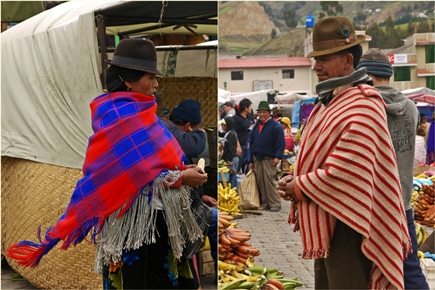
We visit the colourful Saturday market in Zumbahua and take note of how the locals wrap up against the cold. I'm still not convinced that the trademark felt hats worn in these parts are enough to keep you warm but teamed with a colourful poncho and layers of blankets, they do look very fetching.
Rollercoaster to Riobamba
April 2nd, 2013
There’s something about the first couple of hours riding every morning. For me these are the golden hours, the times when my head is full of freedom and optimism, and I feel like I could just keep riding and exploring forever.
The early morning caffeine has kicked in, and every sense is heightened, on edge. I fill my lungs with clean, crisp mountain air. My legs feel fresh, the fatigue of yesterday’s riding long forgotten. The gradients which had me wobbling to grind out the last few kilometres the day before no longer feel so steep. Even my bike feels lighter – now part of me, rather than just a heavy weight trying to drag me back down each hill. Pedalling seems like the most natural state in the world; the possibilities endless.
This is when the Andean light is at its best; a pure, high altitude light in which colours become more vivid and objects more alive than I’ve ever seen before. An Ecuadorian colour palette: the cobalt blue of the sky and the rich greens of the patchwork fields, broken only by the splashes of red or purple from the shawls of figures high on the hills.
Old men in ponchos grin, and doff their felt hats as we ride past. “Pa’ dónde van?” (“Where are you going?”) they ask, twisting their palm upwards in that questioning latino way. We shout the name of the next village, and they just laugh. “En bici?! Suerte!” (“By bike?! Good luck!”). Pigs on leads run through the streets, driven out to pasture for the day by children wielding sticks. Toothless old ladies suddenly pop up out of the verges, knitting in hand while they watch over their roadside flock of sheep, goats or llamas.
And it is always on backroad rides like this one from Quilotoa to Riobamba that I feel my early morning freedom most intensely. This route was no exception; a real rollercoaster through beautiful valleys, sleepy villages and lively markets – all with a healthy dose of mud and lung-busting Ecuadorian climbs thrown in for good measure.
A big thank you once again to Cass Gilbert for trailblazing this route, and for tempting us off the tarmac and onto the dirt with his account.
James
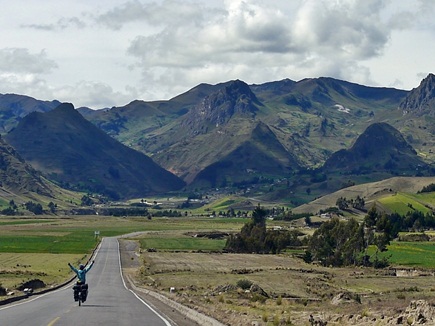
Not many rides in Ecuador start like this: a smooth, fast descent from Quilotoa…

…past more of those classic patchwork fields of green…

..and towards Zumbahua, where we'd visited the market the day before. Today, the town feels sleepy, hungover even – but not enough to stop Sunday League football, which is in full swing against a looming Andean backdrop.

From Zumbahua, we wind our way slowly up on the paved road towards Quevedo, before turning off onto a dirt road across the páramo towards Angamarca – “Nido de Condores”, or “The Condors' Nest”.
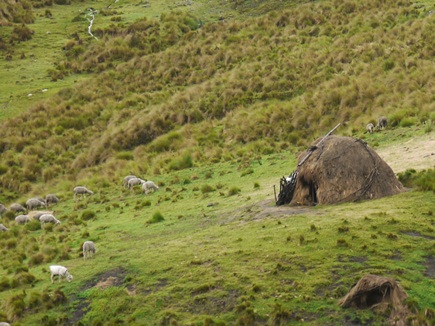
As the road winds its way up past thatched shepherds' huts, the clouds close in, the rain begins to fall and we start to get that cold and wet páramo feeling. A bus driver stops to ask where we are headed. “Angamarca!” we reply. He bursts out laughing, and rolls on.

Eventually we hit the top of the pass and begin a freezing descent, pausing to defrost our fingers and admire this Superpig in his fertiliser bag cape. You know it's wet when even the pigs are wearing their rain gear…
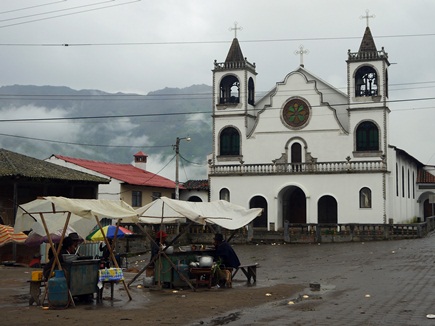
…and we are truly sodden by the time we roll into Angamarca. We get lucky – it turns out the village is home to an Italian mission, and the priest takes pity on the two soggy cyclists asking for permission to camp on his very nicely-tended lawn. Within half an hour we are set up with bunk beds, sipping espresso and tucking into a pasta meal. Grazie mille Padre Bautista e Mario!
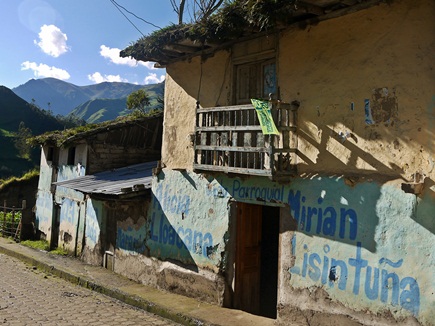
The next morning the sun is shining, revealing Angamarca in all its tumbledown, friendly charm.
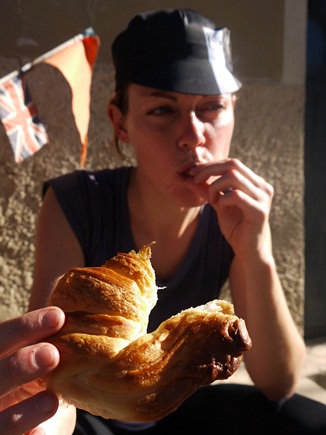
We head for the village bakery to begin our daily search for cheap, filling calories. To our delight, Ecuador seems to have far more sophisticated bakery tastes than Colombia. Baguettes, brown bread that's not sweet, and, best of all… croissants, or cachos as they are known here. We sit in the sunshine and devour a batch fresh out of the oven.
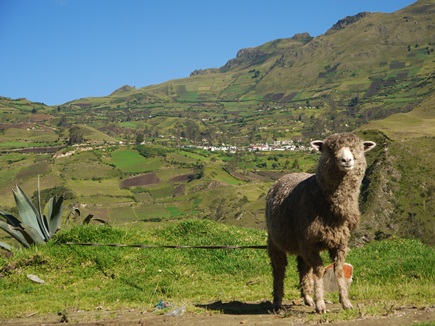
From Angamarca, the Cordillera begins to drop away towards the coast, and we descend – past sheep, cows and goats brought out to the roadside to graze, watched over by young children and old ladies…
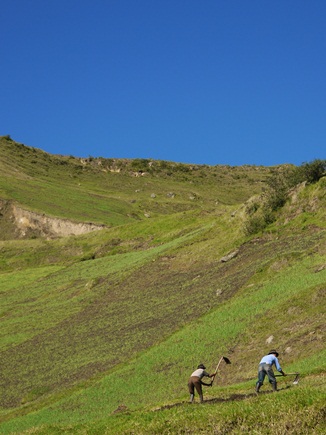
…and past farmers working the impossibly steep fields. Before reaching the town of El Corazón, we turn off in Pinllopata onto a seasonal track which should lead us towards Simiátug.
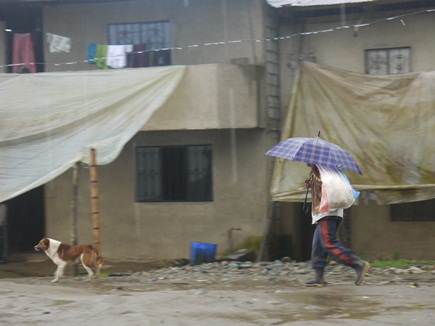
Just as the now regular afternoon deluge begins, we make it to Quishpe, a sorry cluster of houses draped in plastic sheeting for the rainy season. We shelter in the porch of Maria's shop, and watch as the basketball court where we are planning to camp begins to fill up like a swimming pool…
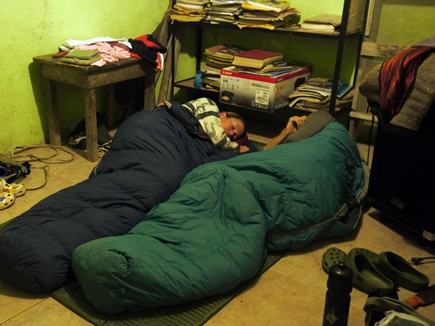
…and so when Maria offers us a spare room to roll out our mats, we are quick to accept.

The next morning the rain is still falling, and even the donkeys are refusing to budge. Gradually though, the downpour eases and we set off nervously, expecting a mud-bath…
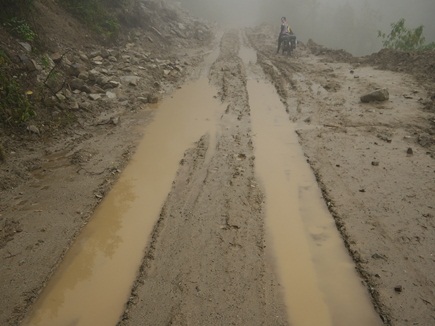
…and we're not disappointed. Luckily though, most of the route is still rideable…
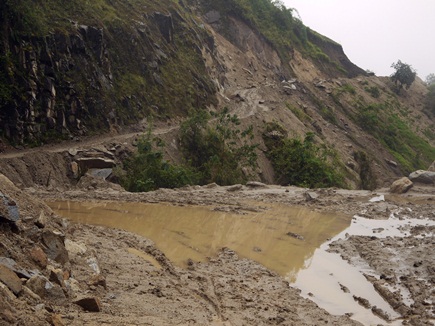
…give or take the odd minor landslide, which calls for a bit of push and shove. Somewhere under here, there is a track.
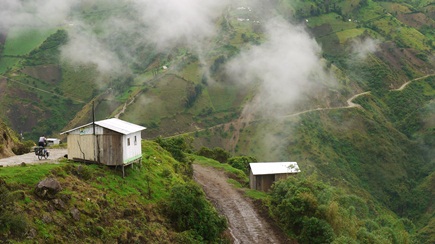
By mid-morning the clouds begin to disperse, breaking the misty bubble we have been riding in, and revealing the road snaking ahead, ever upwards.
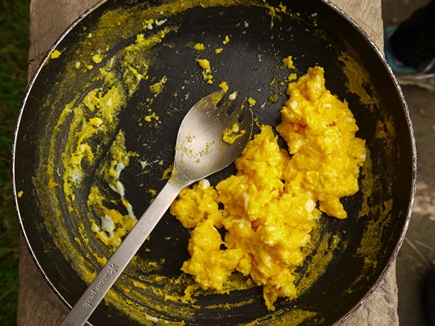
By Mindina, a calorie crisis is looming and we set about finding the village shop. It's dusty and half-empty, but with the stove on hand you can always rely on bread and eggs to plug the gap. Possibly the yellowest eggs I have ever eaten – somehow I think they may have been free-range.
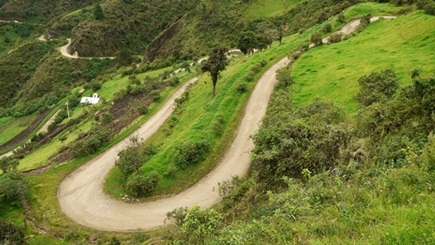
We had been warned that this leg to Simiátug had a sting in the tail, and so it proves. Some very thoughtful, very un-Ecuadorian switchbacks provide the warm up; followed by a far more typical, brutally steep and direct last few km into Simiátug.

The scenery as ever does its best to distract, as we crawl our way up through a beautiful lush valley peppered with wild flowers. Not for the first time in Ecuador, it feels like we had been transported back to Scotland or the Lake District.

Gourmet street food, Ecuadorian style. After days of fantasising about chips (our food fantasies go through these phases), we make it to Simiátug and Sarah finally gets to indulge. It definitely feels like we've earned them.

After a night snoring peacefully on the floor of the office of the Ministry of Agriculture (long story), we set out to explore Simiátug in the morning sunshine. It's a friendly, well-worn place – all ramshackle wooden balconies…
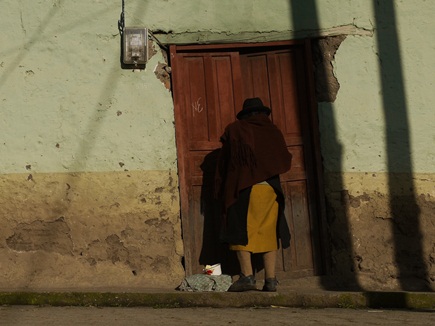
…peeling walls and intriguing doorways.
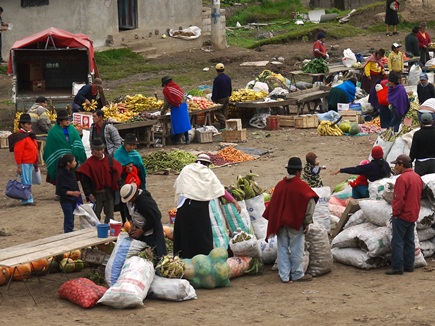
By pure luck, we've managed to coincide with the town's weekly market. It's by far the least touristy and most interesting we've seen so far – piles of fresh veg laid out on simple wooden tables…

…and the effortlessly cool Ecuadorian felt hats. Gringos need not apply.

Forget poncy cycle tourists, these guys are the real heroes of the Latin American cycling world. They spend all day every day hauling massive loads on their cargo bikes – and still manage a friendly grin.

We come across a guy who must be in his seventies struggling to push his bike loaded with chairs, tables and salted fish up the slope into the market place, and so I offer to lend a hand. Don't worry, I say, I've had a bit of practice at pushing heavy bikes up hills around here.

Back in the main square, the local volleyball tournament is in full swing as the mist rolls in. This seems to be Ecuador's national sport, with courts squeezed into flat spaces in even the most tiny of villages.

The next morning, we set off towards Chimborazo and Riobamba, hoping to make it in time for Easter. In accordance with Bolívar's First Law of Andean Town Placement, Simiatúg is conveniently nestled halfway up the mountainside – meaning that as well as a climb into the town, we are treated to a climb out of it as well…

…up towards the distant radio masts.

Even on rested legs, it's not easy, gaining 1,000m over just 14km into a vicious headwind…

…but by the top, we really are up above the clouds. At least, you'd think, we'd be rewarded with a decent descent…which we are – except it's cobbled. And so after 10km of truly unsatisfying, bone-rattling descent, we pop out onto the Vía Flores, feeling like we've just stepped out of a blender.
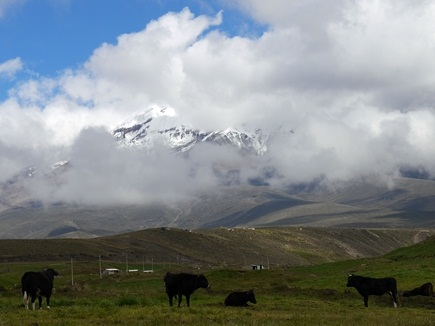
However, this is where we do get our reward – a first view of the snow-capped Volcán Chimborazo, the highest point in Ecuador's chain of volcanoes at 6,310m.

With time running short, we decide to take the paved loop around Chimborazo instead of the tempting dirt option through the middle. It turns out to be a good decision, as we are treated to spectacular views of the mountain in the evening light…
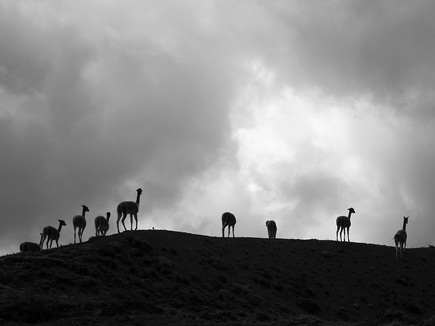
…with herds of beautiful vicuñas (a wild, more athletic type of llama) grazing on the lower slopes.
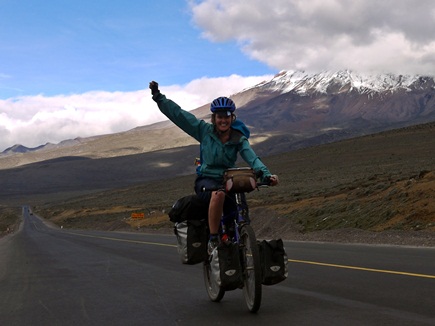
Surely we're allowed at least one cheesy “girl conquers volcano” shot, right? Go Bedders!

After probably our most freezing night to date sleeping in the half-constructed Chimborazo visitor centre at 4,350m, all that's left the next morning is an easy coast down towards Riobamba – but not before Chimborazo allows us a sneaky summit glimpse in the early morning light.
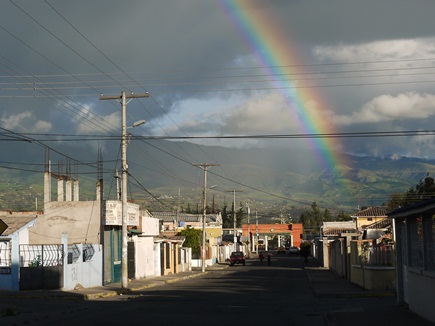
We roll into Riobamba on Good Friday, hoping to sample the traditional Ecuadorian Easter dish of fanesca – a soup made with 12 different grains and topped with cheese, salted fish and boiled egg. Within minutes of arriving, Ecuadorian hospitality strikes again – we are adopted by Ruperto, and spend a brilliant afternoon with his family of 40 sampling the fanesca they have spent the last two days preparing.
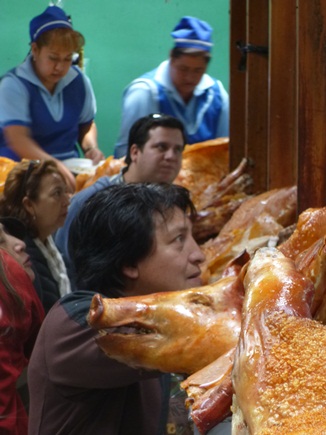
Appetites still raging, on Easter Sunday we head to the market to experience another Ecuadorian culinary tradition: chancho horneado, or roast pig. It's like a scene from a vegetarian horror film – imagine a room with wall-to-wall pig heads and parts, presided over by ladies in blue surgeons' uniforms wielding huge carving knives. Now I know what happens to all those roadside pigs – but it has to be said: the crackling is to die for.
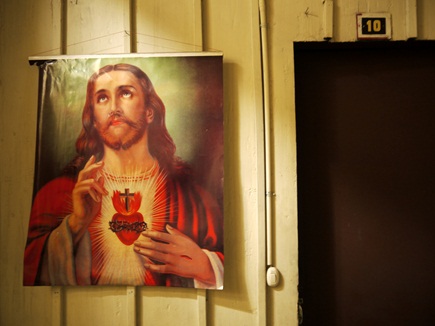
Finally sated, we head back to our characterful hotel room, which – in keeping with the Easter theme – is presided over by a beautifully coiffeured Jesus. “Please Lord,” he seemed to be saying…”Just spare them the cobbled descents.”
Route tips:
We used Cass Gilbert’s excellent route description in the Need to Know section of this blog post.
In Angamarca, we found out about a more direct up-and-over dirt route to Simiátug. This would have avoided the descent to Pinllopata and subsequent climb back up, but we were told that it would be pretty much impossible in wet season with heavily-loaded bikes. It sounded like it could be an interesting dry season alternative though.
We were also sorely tempted by Cass’s dirt route between Volcán Chimborazo and Carihuairazo, but in the end opted for the paved, more direct option into Riobamba. The cobbled descent from Simiátug drops you onto the Vía Flores (a paved, quieter road out of Ambato). Turn right and it’s about 10km to the main Ambato-Guaranda Road, where you can then pick up the loop road towards Riobamba. The first Chimborazo refugio is not at the park entrance as we thought – it’s another 8km of dirt uphill. Luckily, the guards allowed us to sleep in the half-finished new visitor centre, as we arrived just as it was getting dark. It looks like this visitor centre will also have accommodation eventually though.
Meeting the locals
April 14th, 2013
Much of the time atop my bike, shiny silver panniers gleaming in the sunlight, polystyrene helmet perched on my head, lycra rippling in the breeze, I feel more than a little stupid. We are travelling through rural areas, with backdrops of grass, mud, rivers, manure, trees, woven fabrics and farmyard animals…to say we stick out like sore thumbs is an understatement. If I was hoping to blend in, I’m not sure I thought through the colour scheme and fabric choices for my kit properly before we left the UK.
The routes we’ve chosen lately don’t see many long distance cycle tourists passing by. Riding through tiny indigenous villages, miles away from main roads, the sight of two gringos – on bicycles of all things – leaves many we pass with mouths wide open, pointing and shouting for relatives to come and take a look at the lycra-clad spectacle rolling past.
I sometimes wonder if I will be able to adjust to life after this trip when we are not being stared at. Intensely uncomfortable at the outset with being gawped at and crowded around, now I almost expect an audience when we park the bikes in a village and head to the local bakery.
Those who crowd ask hundreds of questions, the most common one being: “Why?”. Why would we want to cycle our bikes all the way down a continent just for pleasure? Saying that we have a passion for travel and a love of riding our bikes sounds so frivolous in comparison to the daily grind we encounter here. When we are talking to those we meet in the countryside, who are dragging their pigs to a patch of grass or walking with an incredibly heavy load on their backs, I want to lie and claim the trip is for something noble or important.
It’s often difficult to explain that we’ve come from the other side of the world to explore South America, when people we meet have often never visited their nearest big town, let alone their capital city. The best dollar we have spent in a long time was on a globe (travel-sized of course) to show people where in the world the UK is and the places we have travelled through on our journey so far. What amazes many is just how small the UK is; perhaps the name “Great” Britain makes many imagine a country as grand in physical size as its status in history.
Sometimes we don’t get chance to stop and chat; we go slowly and like to talk, but not so slowly that we can spend the whole day stopping to talk to everyone. In place of conversation, I try to make a point of at least smiling and saying good morning/afternoon to anyone within shouting distance. It’s amazing what a smile can do. A universal ice breaker, reassurance, a sign of peace, friendliness and solidarity. Many are visibly taken aback when they receive a smile from a stranger on a bike who has suddenly appeared in their familiar environment.
Yet the immediate and almost involuntary reaction of most is a smile back to me in return; that most basic of human interactions which transcends language and culture. I may seem alien, with spaceman panniers and a mushroom helmet, but smiling at each other bridges a thousand differences.
Sarah
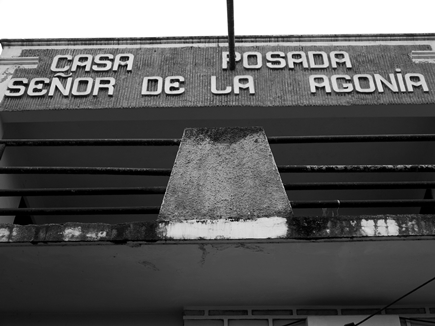
Leaving Riobamba with a bit of a false start: James has a dodgy stomach – perhaps an overdose of Easter eggs – and we cut short our day after just 20km in the small town of Punín. With no accommodation available, we ask at the nearby convent and the priest grants us permission to camp indoors at the aptly named Posada Señor de la Agonia or “Guesthouse of the Lord of Agony”.

We pass a series of Cuban-style billboards extolling the virtues of a newer, happier, Ecuador since President Correa has been in power. The link between national pride and the girl with a lamb is still unclear to me.
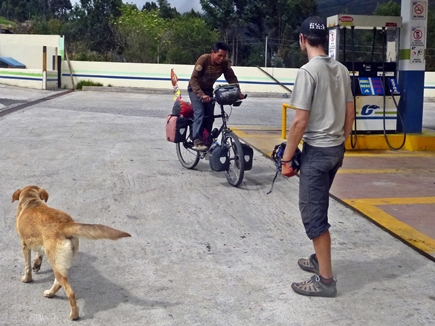
It's clear that this guy has had a dull morning when he jumps up and demands a test-ride of James' bike as we pull into the petrol station to fill up on fuel for our stove. James looks on anxiously as his baby is taken for a turn on the forecourt.
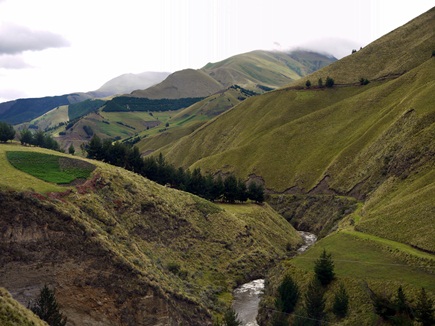
The ride to Lagunas de Atillo is beautiful, on a blissfully quiet paved road. We happily spend the day switching between waving and chatting to farmers and soaking up the wonderful rolling scenery.

I feel the estate agents' spiel would read something like: “Quaint country cottage with thatched roof, open fire and original features”.

The spaceman panniers look a little out place leaned against the wall of school at Punto Cero where we camped for the night…
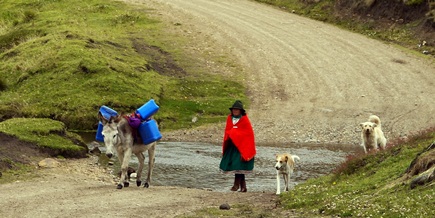
…but it does often bring you to places where seeing donkeys crossing rivers is more common than seeing a car.
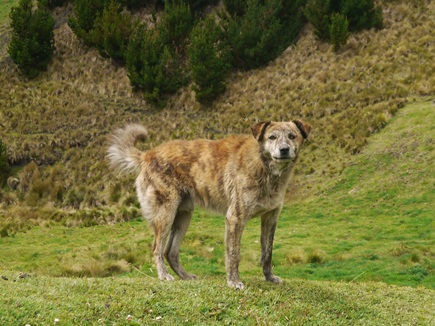
…but would rather see less of the vicious dogs. We're encountering more yappy and aggressive hounds here than anywhere else so far.

Camped on a manure pile (another first on our campsite list), we provide endless entertainment to Hector who lives nearby. He spends the evening running backwards and forwards delivering fruit to us from nearby bushes.
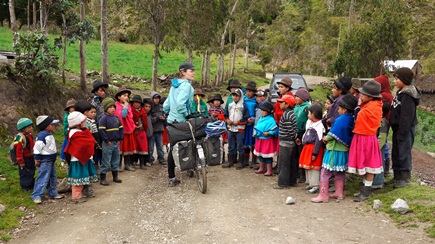
The following morning we waving goodbye to Hector, we ride straight into the middle of a group of inquisitive school kids. One is foolishly brave enough to ask about our trip…

…and out comes the globe for an impromptu geography lesson. I've never seen such an amazing collection of hats.
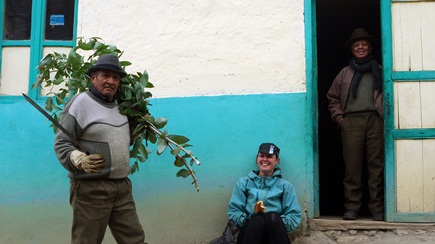
In Achupallas, a man with the machete insists we take his picture – and you don't disagree with a man carrying a machete.
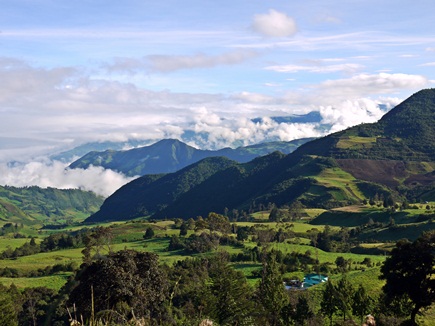
The thought of spending a day on the Pan American heading towards Cuenca was filling us with dread, but thankfully the traffic levels are not as heavy as anticipated – and the views are still as epic as out in the sticks.
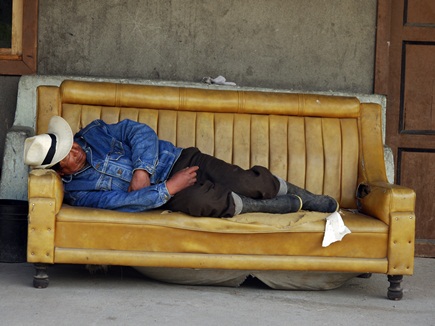
At 1030 in the morning, this fella is already enjoying the after effects of a session on the local firewater.
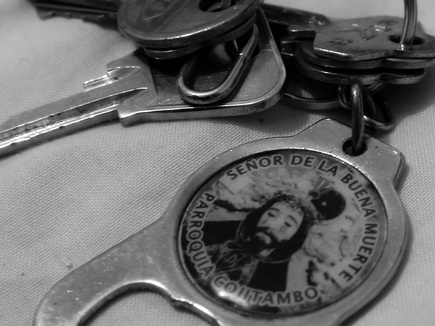
Just outside Cuenca we arrive in little Cojitambo after a long climb up as the sun is going down. We're fortunate to meet Natividad, a lady who runs a shop in the square. She promptly gives us a room to sleep in complete with our own set of keys; the keyring reads “Lord of the Good Death”…is there such a thing?
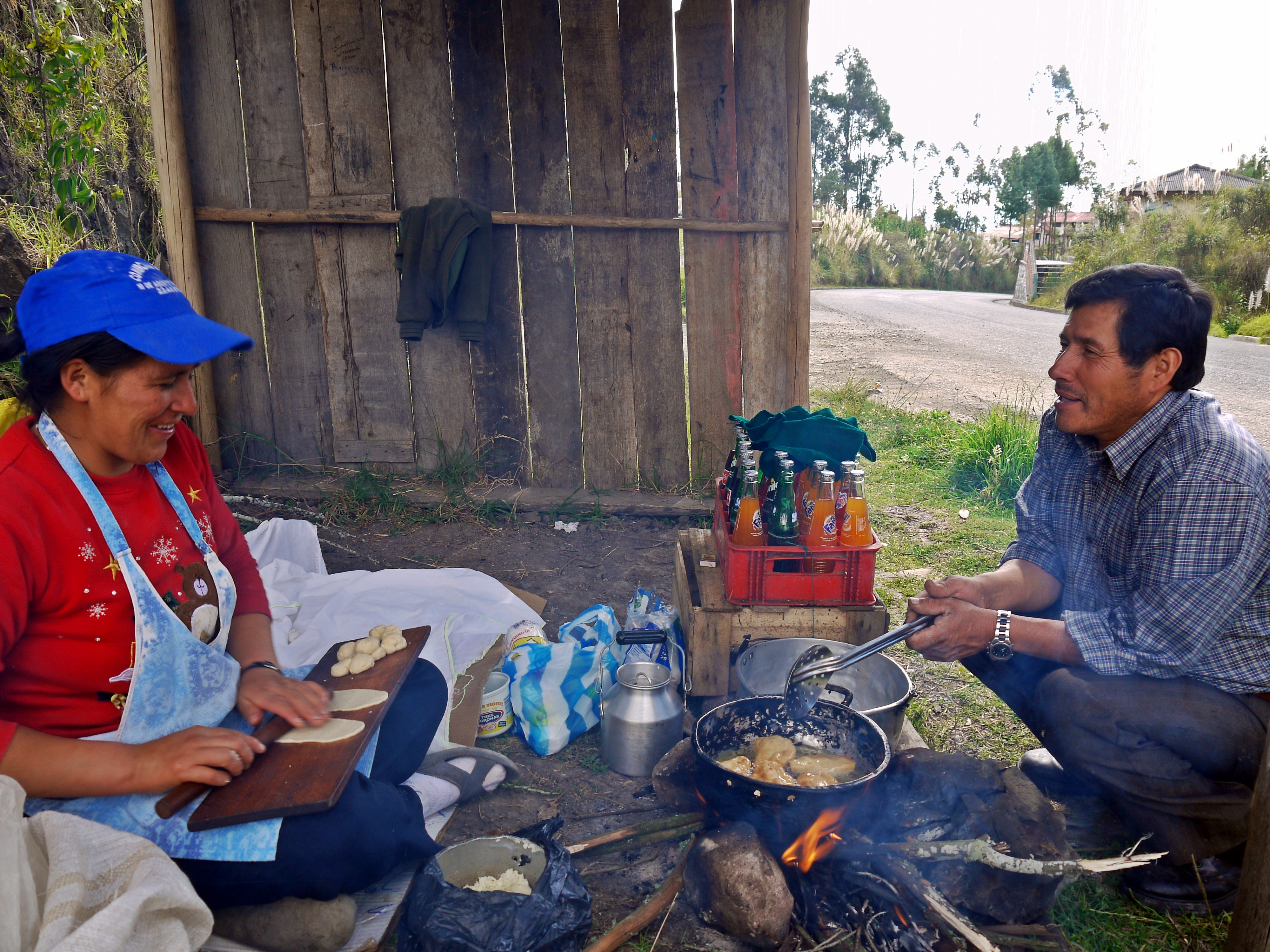
We can't resist making a final stop before Cuenca when we see Yolanda and Luis making empanadas over a wood fire by the roadside. Talk covers politics, geography, education and of course national cuisines. Soon two hours have passed by and we have eaten more than twenty of the delicious fritters. On a carb and sugar high, we ride the remaining 30km into the last major city in Ecuador.
Route tips:
We wanted to go from Riobamba to Cuenca, but without the 80km descent to Macas and subsequent climb back up into the sierra. Our compromise was to climb as far as the Lagunas de Atillo, before cutting west on some unmarked dirt roads to join the Pan American for a day into Cuenca.
The paved road from Riobamba to the Lagunas de Atillo was relatively traffic free with pretty countryside – around 100km. We then backtracked from Atillo to the junction at Punto Cero – 8km before the lakes – and headed towards Osogochi. There are a number of tracks around here so ask for Poca Totoras and Osogochi. From Punto Cero, it’s a 3km climb on dirt road followed by 7km on mud/dirt (a bit of pushing required if it has rained a lot) to reach Poca Totoras. From here, the road improves with 3km of good dirt bringing you to Osogochi.
It’s a 9km climb from Osogochi to reach a newly paved road – turn left to Totoras or right to the Pan American at Palmira. We chose left and after 5km went through Totoras (market day is Wednesday), before joining another good dirt road (beautiful ridge riding) for 26km to Achupallas.
From Achupallas there is a white-knuckle 15km descent to the Pan American at La Moya. From here you can take a right to Aluasí, or we went left to Chunchi – a further 20km. Our total distance from Punto Cero to Chunchi was 93km.
Recipe: Rhiannon flatbread
May 16th, 2013

Rhiannon flatbread: flour, oil, salt, water and a hot pan
Flatbread was one of the food highlights for us during our month at Rhiannon. On the road we crave quick and easy fresh bread. Flatbread is the perfect camping solution, but a couple of less than successful attempts had put us off.
Enter Helen’s recipe, which makes great bread with ingredients that you can find in even the dustiest of roadside tiendas. No need for baking powder or to wait and let the dough prove. The secrets seem to be the hot water, which keeps it light, and the oil, which means you can dry fry.
Ingredients
To make 10 flatbreads
– 3 cups of flour (white or wholemeal, a mix works well)
– A few pinches of salt
– Couple of drops of oil
– 1 cup of hot water (not quite boiling)
Optional: any dried herbs/spices you have available – oregano, rosemary or cumin work well, or add cinnamon and panela to make a sweet version.
Method
– Mix the flour, salt and oil together in a bowl.
– Slowly add the hot water and knead to an elastic dough.
– If the mixture is still wet, add flour until it stops sticking to your hands.
– Roll the dough out into one big shape, about 1/2cm thickness. If you’re camping, lay out some plastic bags on a flat surface.
– Spread the dough on one side with a thin layer of oil.
– Roll the dough up into a long sausage shape.
– Slice the sausage up into 10 (or however many breads you want to make)
– Roll out each bread individually into the thickness you want – about ½cm for chewy, naan style bread; or thinner for tortilla style.
– Dry fry in a hot pan until it browns.
South African stickbread
If you have a campfire, then stickbread is a delicious and easy variation on the flatbread recipe. It comes courtesy of the Rhiannon South African contingent, Jaco and Stefan, who cooked an amazing meal for us one night of stickbread and veggie kebabs.
You can also try the recipe with beer instead of water – easy bread with just beer and flour!
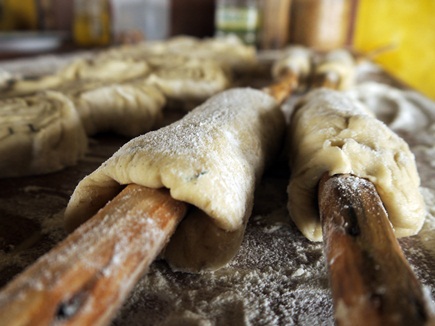
South African stickbread: just add campfire
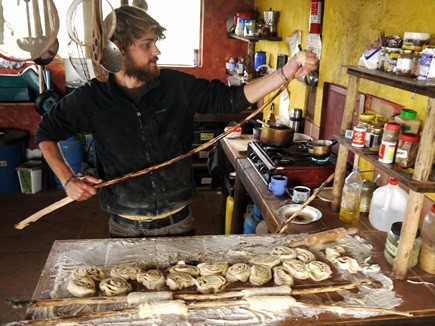
Use exactly the same recipe and method as above, but once you have rolled up and sliced the bread “sausage”, simply skewer each bread onto a fresh, green stick…
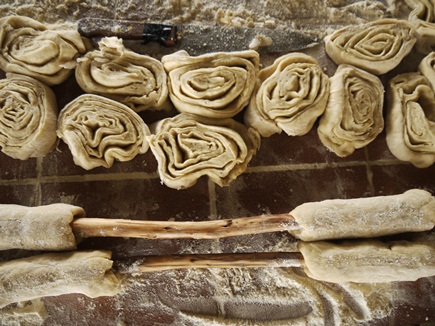
…you should end up with something that looks like a bread barbell.
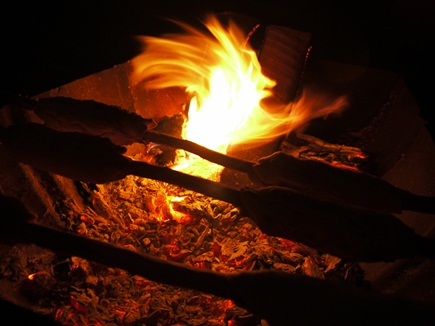
Hold the stick over the embers and rotate. Once it’s cooked, the bread will slide off, and break into crispy, pastry-like layers. Buen provecho!
Rhiannon: grub’s up!
May 17th, 2013
“Eat Food. Not too much. Mostly plants.”
Michael Pollan, In Defense of Food
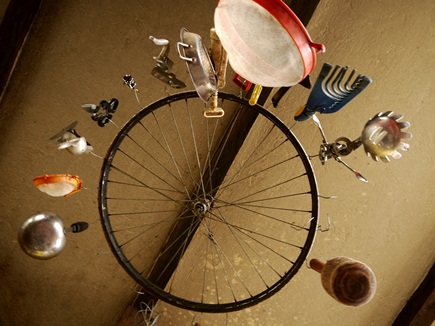
Every good meal begins with a bike: select your kitchen implements from Rhiannon's bike wheel of culinary fortune…and start improvising.
I have to admit it, I was nervous. A month on an organic farm in the middle of nowhere, eating a largely vegan diet cooked by other people? For a touring cyclist who has spent most of his waking hours over the past two years plotting his next food hit, surely this was, well, food suicide?
The vegan bit didn’t bother me – our diet on the road is almost entirely vegetarian, and I figured I could cope for a few weeks without eggs and cheese – but the other people bit did. Imagine handing over control of my daily calorie intake to a group of people I’d never even met, most of whom weren’t even cyclists? Forget riding centimetres from enormous 18-wheel trucks, or wild camping at the mercy of imaginary thieves or murderers, this felt by far one of the riskiest things we had done all trip.
Get a grip, I told myself – surely it can’t be that bad. Challenge yourself. Get out of your food comfort zone. And so, with a pannier stocked with bread, jam and bananas – the hungry cyclist’s international safety blanket – I set off in trepidation. As we rode through the last few villages before the farm, I made a mental note of the nearest bakeries – distance, road surface, elevation – and calculated how long it would take to ride there in a crisis situation. Better to be prepared, I thought.
I really had nothing to worry about. Over the past month at Rhinannon, I have eaten some of the most delicious, healthy and inventive food I have ever eaten. If I feared a food crisis before I arrived, then I left with a food education.

Breakfast is the simplest and quickest of the three meals, but still delicious: porridge with panela (brown sugar), fruit salad with pineapple, orange and banana, and hot, deep fried empanadas.
Cooking at Rhiannon is a communal affair, with a group of typically three volunteers responsible for cooking each of the three meals a day for between 20 and 25 people. There are no rules, no set menus, no real recipes to speak of – improvisation is the key, and as long as it tastes good, and there’s plenty of it, no-one will be complaining. We were lucky enough to be there at the same time as a group of volunteers who shared our passion for food, and at times it resembled some kind of International Masterchef as people competed to out-do previous meals. For a couple of food junkies like us, it was the very best kind of competition to be involved in.
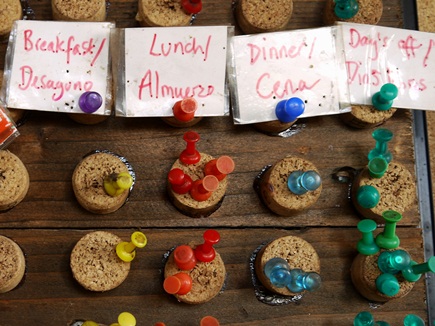
The Rhiannon cooking rota board: culinary battle lines are drawn.
Iin the spirit of Ready Steady Cook, every meal is concocted from whatever is available on the day. The larder is always stocked with a vast array of grains and pulses: rice, lentils, oats, various beans, chickpeas and quinoa.

Daily salad harvest from the Rhiannon garden.
To this is added a daily harvest of salad leaves and vegetables from the garden, plus a weekly delivery of fruit and vegetables to top up Rhiannon’s own fledgling production. For flavour, there is a good range of herbs and spices, plus plenty of flour and panela for pancakes, bread and pastry.
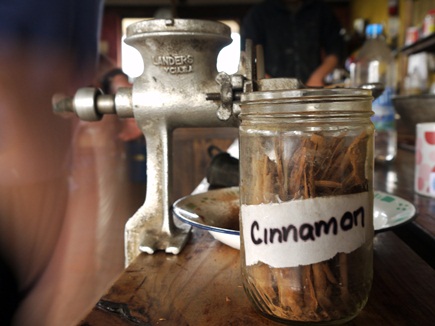
Cinnamon: grind fresh and add liberally to porridge, pancakes, cakes and biscuits.
I had thought that cooking vegan food would be tough – but it really wasn’t. Firstly because there were no non-vegan ingredients in the kitchen, there was no temptation. If it came out of the kitchen, it would – by definition – be vegan. And secondly because there really are so many good alternatives to dairy. Making really good pie pastry without butter, and delicious pancakes without milk or eggs made me realise that often the dairy element is added just out of habit – and not always because it is really necessary. For cycle touring, where we very rarely have access to a fridge, learning some vegan recipes and alternatives to dairy ingredients really was invaluable.
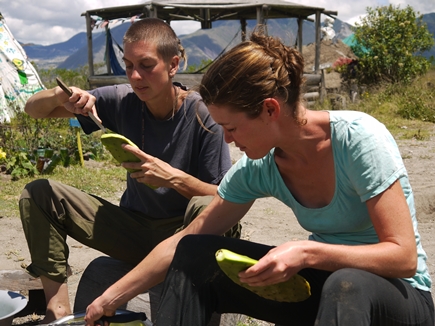
Nothing is overlooked as a food source – after being heated on the burner to loosen the spines, locally foraged nopal cactus is prepared for the pot by Helen and Sarah.
So what exactly did we eat during the last month? In no particular order, here are our top ten favourite Rhiannon dishes – all of them 100% vegan:
- Flora’s carrot cake with lemon icing – a rare cake success in the fire
- Roasted rosemary and garlic potato wedges, served with spicy tomato ketchup and lentil salad – myself and Sarah
- Crepe basket with pineapple and banana, courtesy of Guillaume and Sara, the often imitated but never outdone French duo
- Root vegetable pie with sweet onion gravy – a British team effort
- Matt’s banana pancakes with panela and cinnamon syrup
- Sarah’s chocolate and avocado mousse, served with panela flatbread and uvillas (a sour-sweet berry) from the garden
- Jaco and Stefan’s South African firepit feast: marinated vegetable kebabs, stickbread, salty bean salsa and salad
- Lentil bangers with mustard mash and greens – another British creation aimed squarely at the comfort food sweet spot
- Spicy peanut butter sauce from Sauce Queen Laura
- And last but definitely not least, Rhiannon flatbread – so good we’ve decided it deserves a blog post of its own to share the recipe.
Having both recently read Michael Pollan’s excellent food books The Omnivore’s Dilemma and In Defense of Food , our food experience over the past month has simply served to underline his eminently sensible eater’s manifesto: “Eat Food. Not too much. Mostly plants.”
At Rhiannon, it’s simple to follow his rules. There are none of Pollan’s dubious, “edible food-like substances” – those you find lurking in the middle aisles of your supermarket, with an ingredients list as long as your arm. There are just simple, fresh and tasty ingredients – and when you combine those with just a dash of invention, it becomes easy to keep even the hungriest cyclist happy.
James
Rhiannon: a day in the life
May 18th, 2013
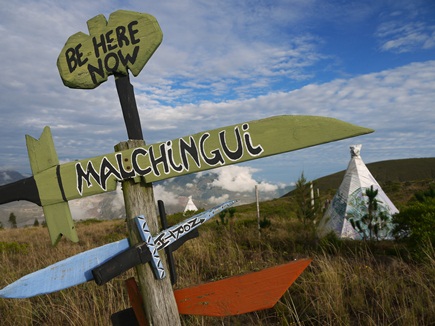
Be here now: welcome to the wonderful world of Rhiannon.
It’s interesting to watch how your concept of a bike tour evolves as you travel. A trip that began as a fairly focused, 18 month bike ride from Alaska to Patagonia has evolved into what we hope by the end will have become a meandering three year adventure – in which what we do off the bike has become almost as important and stimulating as what we do on it.
We quickly discovered that going slowly was our preferred way to travel by bike – riding slow with our eyes open, rather than fast with our heads down. By avoiding the direct routes wherever we can, and opting for the zig-zagging, minor roads, we have given ourselves more opportunities to discover the details of the places we travel through – and most importantly to meet just some of the the people who live there.
Yet doubling the time frame for our trip has not only given us the luxury of going slowly when we are on the bike, but has also opened up the possibilities of actually stopping. Of extracting ourselves from the often introspective, destination-oriented world of bike touring, and opening our eyes to other things that interest us. The past month we have spent at the Rhiannon Community in Ecuador is testament to the fact that – for us at least – this stop-start approach seems to be the perfect bike touring combination.
It would be impossible to do a long bike trip without gaining an increased sense of awe at the power and beauty of the natural world, and at the same time a creeping sense of despair at the rate at which man is destroying it. Moving slowly on a bike through rural areas, camping and living a relatively low-impact, minimal existence makes you think long and hard about our connection with the land, and the natural resources we take for granted. For a long time we had been keen to learn more about sustainability in practice, and working as a volunteer on an organic farm seemed like the perfect low-cost way to do it.
We chose Rhiannon because as novices it seemed to offer a good taster of the broad range of things we were interested in: not just organic farming, but also sustainable construction, community living, yoga, meditation and good vegetarian food – all with a sprinkling of Ecuadorian new age hippy thrown in for good measure. It’s run by Helen and Nicky, an English couple who fell in love with the view from a farmhouse perched on a ridge north of Quito – and decided it would be be the perfect place to start their own sustainable community. Over the past five years, they have transformed what was a piece of over-farmed, arid semi-desert into a thriving community with a family of between 10 and 20 ever-changing volunteers at its heart.
Our experience at Rhiannon turned out to be everything we had hoped for: challenging, rewarding, frustrating and hilarious, often all the the same time. We spent an inordinate amount of time up to our elbows in donkey poo. We learned how to massage each other’s legs after a hard day on the bike. Sarah pulled off a headstand in yoga and I almost touched my toes. We discovered that you can make a pretty good chocolate mousse just with an avocado and a bar of chocolate. We helped design and build a swinging bed, then slept on it and felt seasick. We discovered that for South Africans “flapjacks” are actually pancakes. We watched how waste – from our own pee to glass wine bottles – can nearly always be turned into something useful. In an exaggerated display of Englishness, we said “lovely” and “super” far more than is really necessary. We ate our beloved Marmite for the first time in nearly two years. We almost fainted in a temascal “sweat lodge” ceremony. Oh, and we got parasites. Again.
If hippy means living as sustainably as possible, connected to the land and in a supportive, family community, then I for one came away a convert.
James
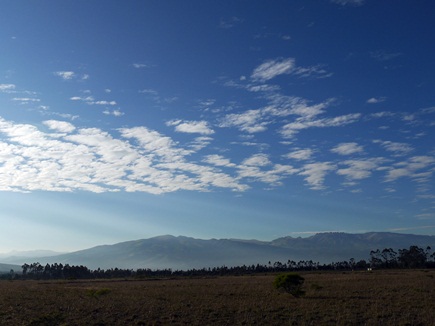
6am. Up early to take in the early morning views. Perched high on a ridge near the village of Malchingui, Rhiannon has a stunning, ever-changing 360 degree panorama…
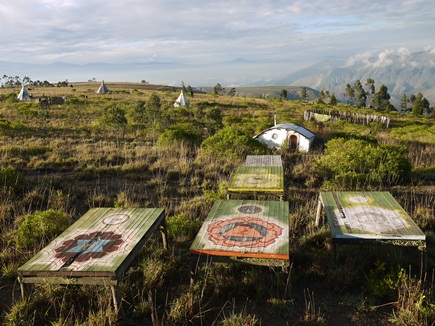
…where mountains and volcanoes loom beyond the tipis and yoga platforms. On a clear day you can see 17 volcanoes from here…
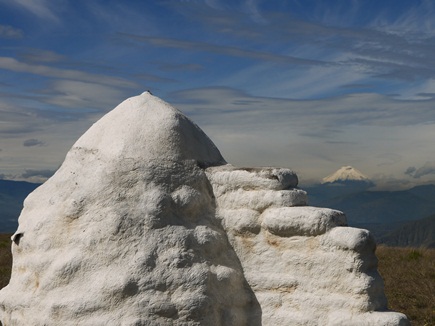
…and as always, my gaze is drawn back to the perfect cone of Cotopaxi – here mirrored by the roof of the Gnome Dome, one of Rhiannon's growing cluster of adobe houses.
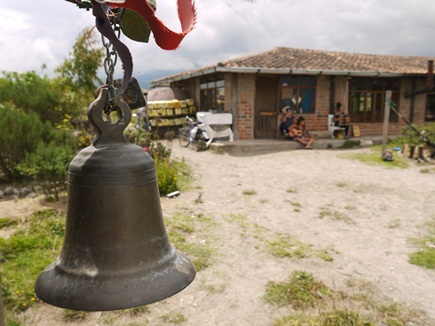
6.45am. Breakfast Bell. Life at Rhiannon revolves around two things: the bell, which means that food is ready…

…and the rota boards, which set out your day's work. As well as the five hours work a day, as a volunteer you are also responsible for cooking one of the three meals each day. The food at Rhiannon was so good, we decided it warrants its own separate blog post.

You're never far from music at Rhiannon. Here Joel – a bass guitarist from the US – and Elizabeth – a yoga teacher from Jamaica – squeeze in a morning session over their breakfast tea.
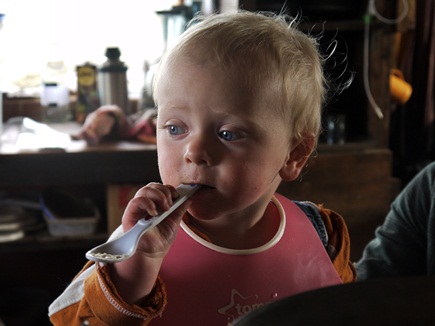
7am. Take on the breakfast challenge: trying to get food into the mouth of Helen and Nicky's daughter Satya faster than she is able to throw it onto the floor. On most days, it's a losing battle.
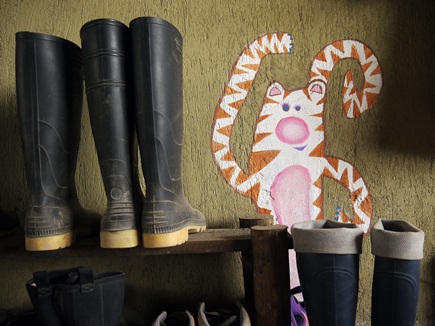
7.45am. Pull on the wellies for morning chores – including feeding the chickens and dogs, taking the donkeys out to graze, cleaning the house and watering the gardens.
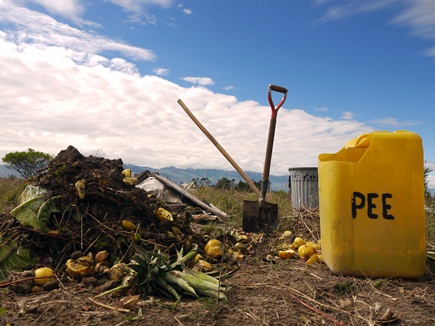
For me, early morning means compost making. Rhinannon's compost recipe is a perfect example of the farm's philosophy in action, where “waste” is turned into something useful. Take leftover organic material from the kitchen, throw in a few handfuls of donkey poo, combine with ash from the fire, and bind together with yesterday's pee collected from the toilets. Cover with plastic sheeting to marinate in the sun, turn daily and bingo – within two weeks you have rich, homemade compost.

8.30am. The day's work begins in earnest. I spend much of my time working on the farm's earthbag houses, which will provide accommodation for future volunteers. First, bags are tightly packed with earth dug from beside the house, before being carefully stacked to form the structure. The hole dug to build the house is then terraced and planted, creating a kitchen garden which will help to feed the community.
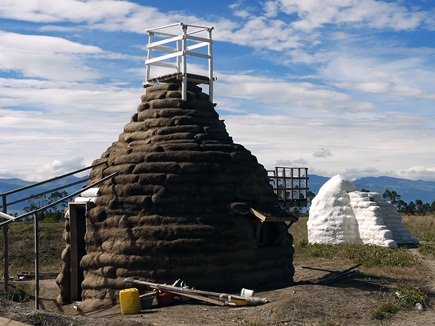
Once the structure of the house is complete, it's covered inside and out by hand with a layer of adobe: a traditional mix of sand, sawdust, water, and – the secret ingredient – donkey poo, which acts as the glue to bind the mix together. The donkeys, Ursula and Freya, are a critical link in the Rhiannon chain – as long as they are pooing, everyone's happy.
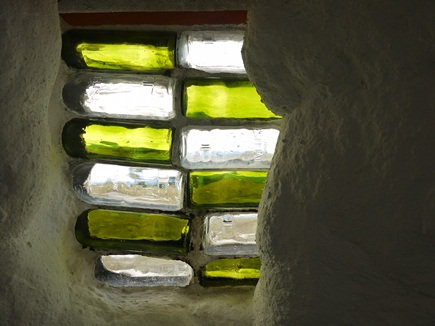
Once the adobe dries, it's then sealed with a coat of paint or cactus juice, making it weatherproof for a good few years. A window made using recycled glass bottles lets in light and provides a splash of colour.

The finishing touches – Nicky decorates the “Snake Pit” in one of the larger adobe houses, where we also helped to construct a swinging double bed from old pallet boards.

And here's one they built earlier, the Hobbit House: an earthbag and adobe home, built largely from local and recycled materials – and all for just a few thousand dollars. A touch more charm and character than your average lego-brick, Persimmon estate house, don't you think? I would happily live in a Hobbit House…
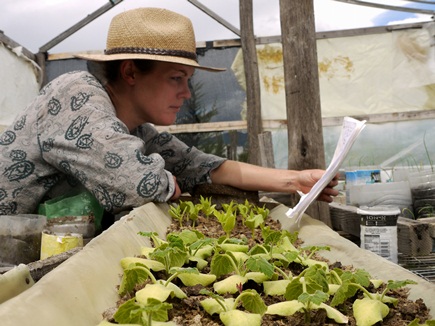
After three weeks of cleaning the donkey poo from under her fingernails, Sarah spends her last week in the greenhouse, cultivating locally collected seeds to grow avocado, beetroot, onion, beans and maize. In the semi-desert climate, everything needs careful nurturing and watering, but the long term aim is for the farm to become as self sufficient in food as possible.
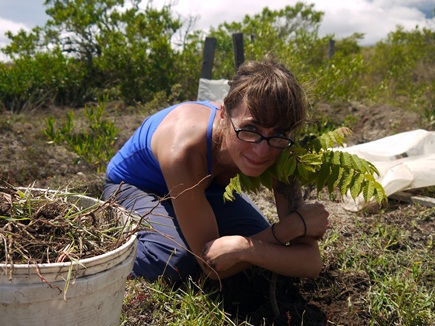
Trees are essential in this process, helping to retain water and provide shelter from the gusting wind. Regular weeding, mulching, a daily dose of pee from the toilets and a hug from Karrey helps them on their way.

1.30pm. With no connection to the grid, power on the farm comes from these solar panels. Hot water also comes from the sun, warmed all morning in a series of outside pipes – making this prime time for a deliciously hot shower before lunch. Used shower water is then directed through natural filters into a lagoon, from where it can be re-used to irrigate the gardens.
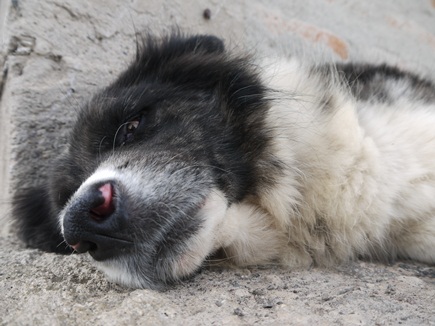
2.30pm. After lunch, work is done for the day and the Rhiannon playground is yours. If laziness strikes – like it often does for Azul, the most relaxed of the farm's seven dogs – then pick a book from the library…
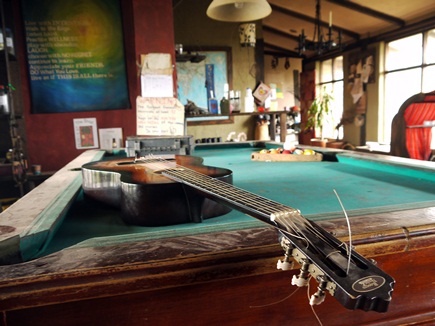
…head for the lounge and raid the stash of local Salinas chocolate in the community shop…
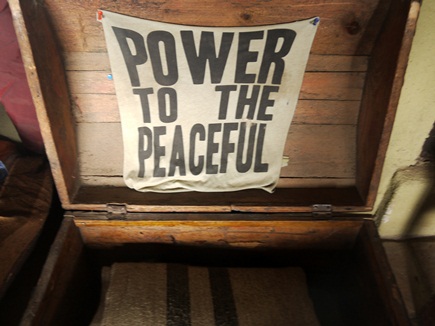
…grab a blanket from the box…
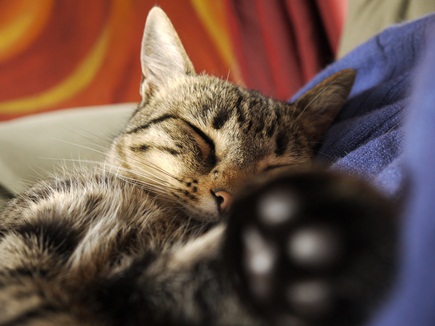
…and curl up. If you're lucky, you'll be rewarded with a visit from Chachi, a cute, ever-purring ball of fur with a magnetic attraction to a warm lap. One evening, she even managed to find her way into my sleeping bag, where she slept quite happily for the night.
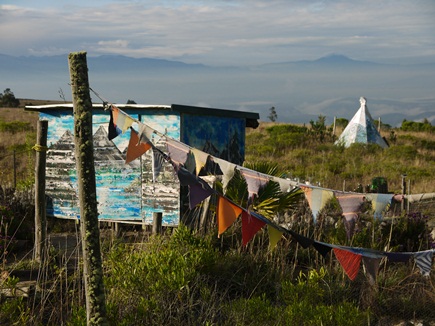
If you're feeling the need for some solitude and contemplation – and you're not claustrophobic – then the meditation hut might be just what you need to help empty your mind.
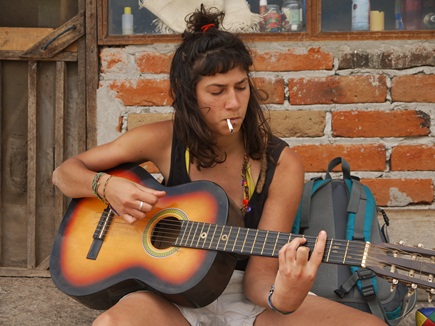
If you're after something more energetic, then there are plenty of options: sing along with Italian Federica…

…join in a hula hooping masterclass led by South Africans Stefan and Jaco…
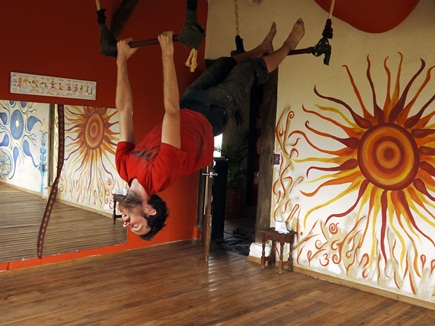
…or even practice some acrobatics in the Yoga Room. Speaking of which, yoga was one of the big draws for us to Rhiannon, and we had a great introduction courtesy of several different teachers…

…including Nicky, who is here demonstrating what is supposedly the yogi “sleeping position”. Not that I got anywhere near this – as a clasically inflexible and hamstrung cyclist, I'm still working on the basics – but we did come away with lots of good new stretches to counteract our cycling posture, and a desire to do much more yoga in the future.
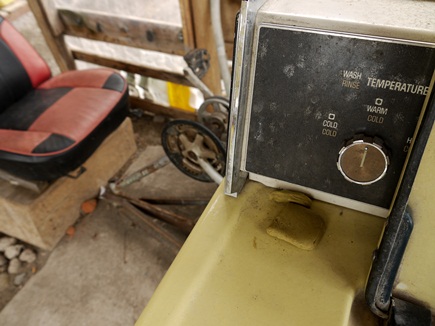
If the smell of your own clothes is becoming overpowering, then it's probably time for a spin in the pedal-powered bicilavadora…

…and if you still have energy left, you could take Isla and Lobo – two dogs with severe attention defecit disorder – for the most unrelaxing afternoon stroll ever.
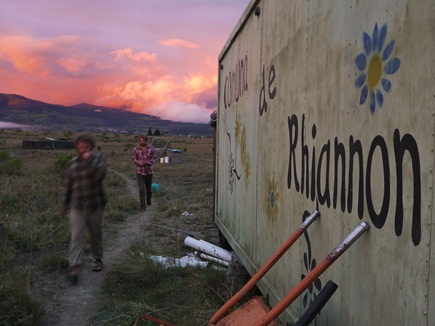
5.30pm. As the sun begins to drop, the last job of the day is to bring the donkeys in. Most days, the clouds have rolled in by now, bathing the farm in mist – but just occasionally it remains clear…
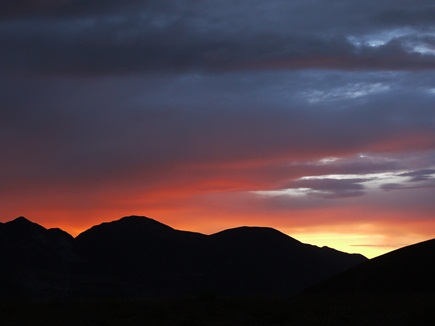
…and the sunset over the mountains is a stunner.
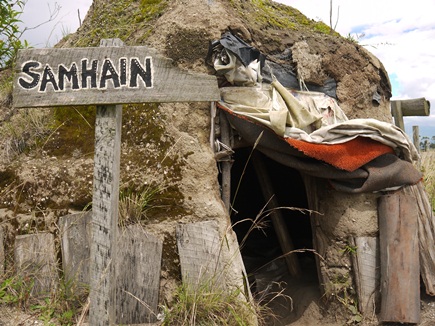
Occasionally there are organised evening activites, like the temascal ceremony which was one of my favourite experiences at Rhiannon. Imagine the most intense steam room ever, but inside a tiny adobe hut in the pitch black, shoulder to shoulder with twelve other people. Then bring in red hot stones which have been heated in an enormous fire, and add water. As the ceremony progresses more stones are brought in and the temperature rises, accompanied by singing and prayers. The aim is that the profuse sweating and meditation acts as a purge – and for me, emerging from the hut into the cool night after two hours was literally like being born again. Thank you Monika for leading an amazing experience.
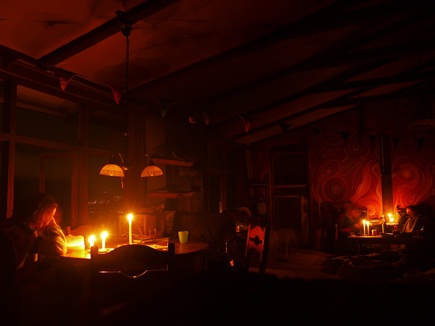
8pm. Otherwise, evenings at Rhiannon are usually a relaxed affair around the woodburner: reading, talking, attempting to make bread or desert in the fire (requires a degree in flame control), or playing board games – Jaco and Stefan's “Beanopoly”, a home-made South African version of Monopoly using beans for currency was a triumph.
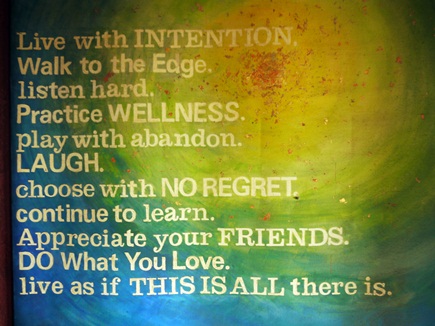
The Rhiannon philosophy – Do what you love. I'm not sure I could think of a better set of principles to live by. A massive thank you to Helen, Nicky, Satya and all the other volunteers for a wonderful month of work and laughter with the Rhiannon family. We'll miss you all!
Decisions, decisions: exiting Ecuador
May 28th, 2013
In our last few weeks in Ecuador, it seemed everyone was obsessed with telling us how much of their country we had missed. Geographically, Ecuador is split into three parts: the coast on the west, the jungle to the east and in the centre, the Andes – which form the spine of the country from north to south. Reluctant to make a long descent to either coast or jungle and then have to make a big climb up again to the cordillera, we stuck doggedly to the mountains.
The head shakes and sighs we encountered when people learned of our neglect of the coast and jungle led us to start asking questions about the route decisions we make. When travelling by bike, you are inevitably forced to choose your route through just one small section of a country, unless you have endless time to divert and wander. Every time you choose one path, another is closed to you (until next time at least) and there’s always a sense that you may have missed something. Had we made a mistake and chosen the wrong path through Ecuador?
After the umpteenth conversation about how silly we were to neglect Ecuador’s “best” sites, we reconciled that it wasn’t about a terrible choice we had made and what we were missing – it was more about learning to accept what we like doing. For the views, the climate, the people and the roads, staying up in the Andes holds the most appeal. This trip has turned us into montañeros – mountain people. Cycling through the mountains might be difficult, but to us it’s far preferable to the humidity of the enclosed jungle and its hungry bugs or the flatlands and scorching dry heat of the coast.
Decision making has become harder and harder as the realisation dawns on us how much South America has to offer. This is magnified by the fact that when travelling as a couple every choice is a compromise, a discussion, often over-analysed and always subject to the second-guessing of your partner. Everything is up for debate: which road to take, where to drink a coffee, what time to set the morning alarm, when to stop for lunch, where to stock up on supplies, whether to cook fried eggs or scrambled for breakfast on a rest day, and even which brand of toilet roll to buy. Thankfully the only thing we really bang heads over is how to eat our eggs.
When it came to deciding whether to cross the border from Ecuador to Peru via the coast or the mountains though, there was no deliberation from either of us: mountains all the way. So with everyone’s advice ringing in our ears, we ignored it and took to the hills south of Cuenca to cross into Peru.
Sarah
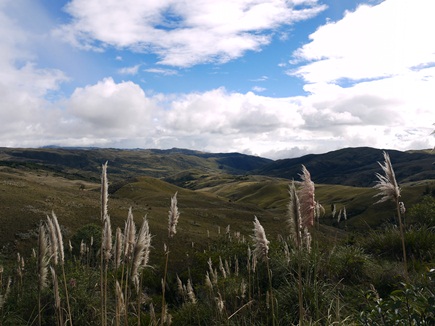
The ride out of town spits us out into the countryside fairly swiftly and after nearly six weeks off the bikes, the legs start to feel the burn immediately.
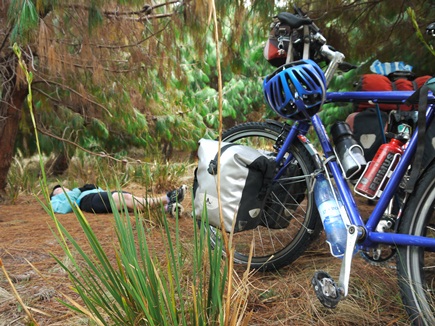
First night’s accommodation turns out to be a cosy little spot nestled among some pine trees at over 3000m…
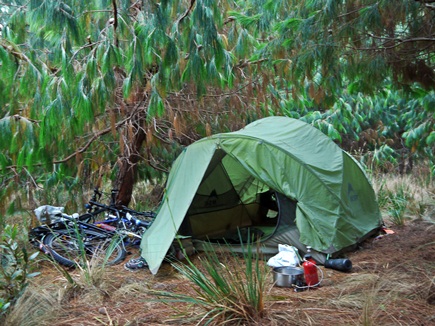
…and as we remind ourselves how to put up the tent on a nice spongy bed of pine needles, the stove bubbles away with a quinoa/pasta feast.
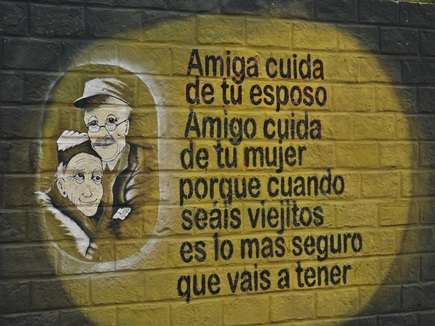
It’s appropriate that we arrive in Vilcabamba – Ecuador’s village of eternal youth – on the day before my birthday. The poem reads “Lady take care of your husband, man take care of your woman, because when you are both elderly, the only sure thing you will have is each other”.
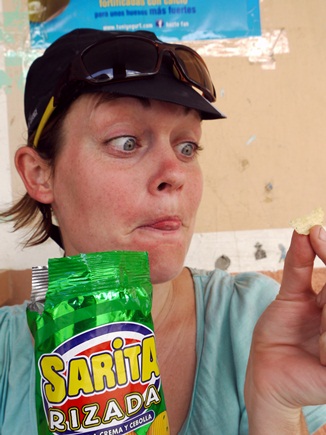
…even happier when I find a packet of crisps bearing my adopted Spanish name; what a treat – doesn’t take much to please this birthday girl.
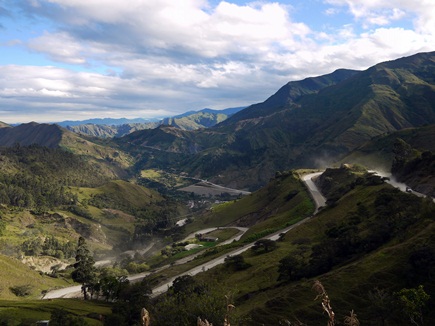
Then after the crisp excitement, it’s back to business as usual the next day with a long but beautiful climb on the way to Valladolid.
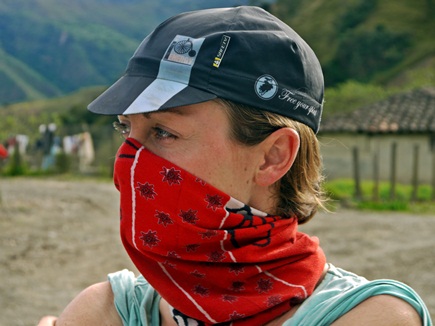
We are warned of major roadworks ahead with accompanying mud and dust so the buff comes out for the chic cyclist/bandit look.
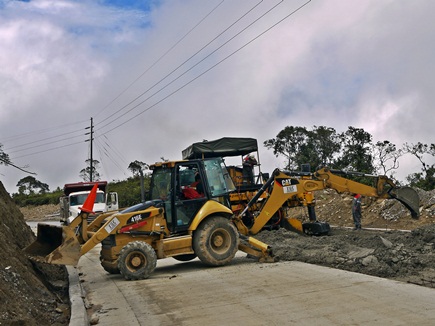
…and ongoing construction provides a chance to stop for a breather and chat to the friendly gangs of engineers who line this part of the route.
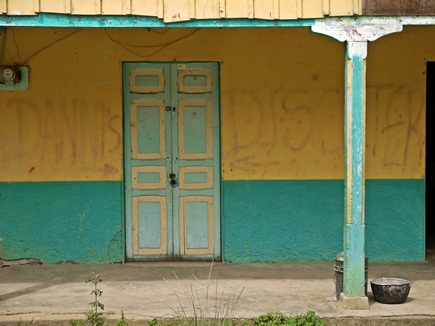
In Valladolid on a Saturday night, on the weekend of my birthday, we are sorely tempted to stick around and see what goes down at Danni’s Discotek…
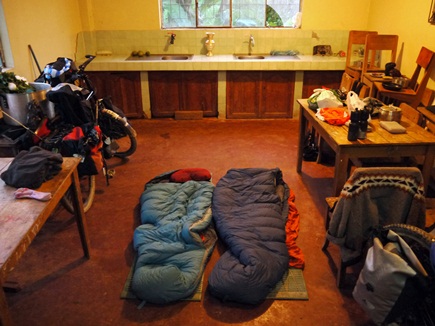
…instead we end the day further along the road at Palanda, camped out in the church sacristy while ladies busily prepare the next day’s flower arrangements around us.
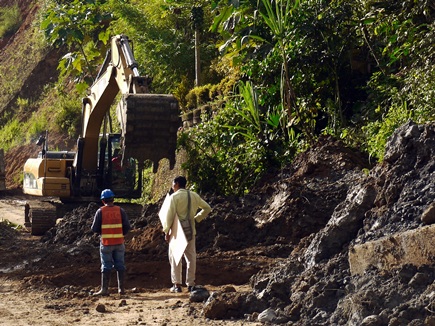
Onto dirt after Palanda, and though the road building continues we are lucky to get away with very little mud – cyclists passing through here shortly before us talked of pushing their way through ankle deep bogs.
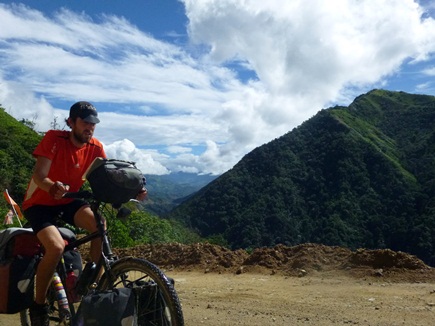
A nasty steep climb in the rising heat has us both seeing stars by the time we reach Progreso for lunch.
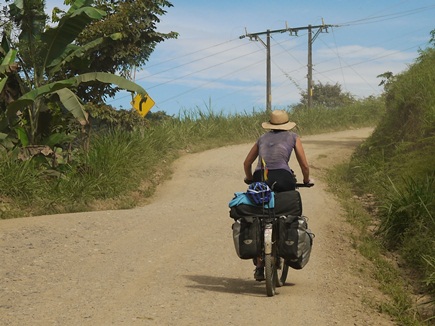
There’s only more of the same after lunch; it feels like we are back in Central America and with sweat pouring off in all directions, we dig out the sun hats, slap on the factor 100 and grind into the pedals. This is by far the hottest weather we have experienced in Ecuador and it feels alien. Making it to Zumba feels like a real achievement.
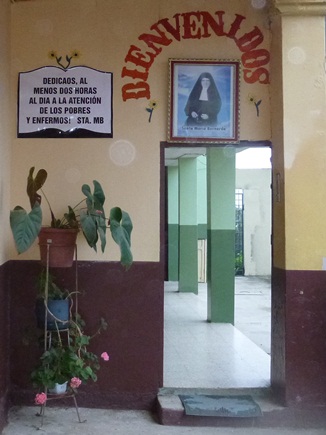
Our last night in Ecuador mirrors our last night in Colombia – spent enjoying the hospitality of the local nuns; we camp in the cloisters of the convent at Zumba…
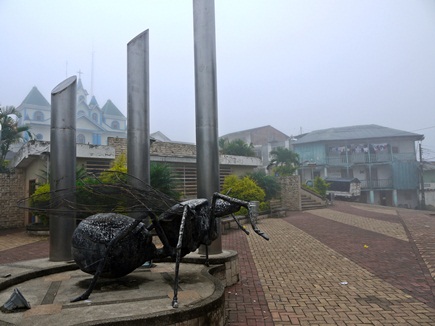
…and in the early morning mist, we leave the oddly placed mosquito sculpture behind us in the town square and set off for the border.
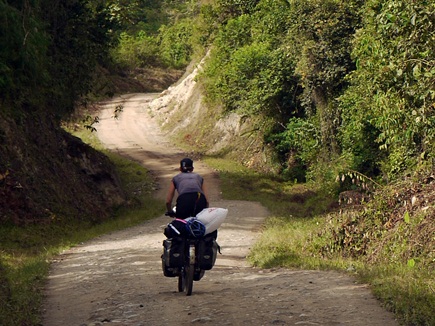
This road through the mountains into Peru is a pretty quiet crossing and the dirt track leading to immigration at La Balsa hardly feels like we’re on the way to an international border.
